Working with Native Services and Integration Interfaces
This chapter covers the following topics:
- Common Information
- XML Gateway Map Information
- PL/SQL Information
- Java Information
- Business Service Object
- Concurrent Program Information
- Open Interface Information
- Interface View Information
- EDI Message Information
- Business Event Information
Common Information
The details page of each integration interface type contains the following two types of information:
-
Interface detail information
This interface detail information includes a header region with general information, a description region, a source region, and an interface methods or procedure and functions region.
Integration repository administrators can perform additional administrative tasks including generating a Web service for a selected interface type if the type has a Web service enabled, subscribing to a business event, and creating security grants for appropriate users.
For more information on interface details, see Common Information on Interface Details.
-
Interface Web service information
Based on the selected interface, you can view the associated Web service information if it's available in the interface details page.
Web service information including the SOAP-based and REST-based services if available for the supported interfaces can be displayed in the interface details page. This service related information such as service status, serviceable operations, service description, and supported service methods can be shown for the selected interface.
Note: In this release, only PL/SQL APIs, Concurrent Programs, and Business Service Objects can be exposed as both SOAP and REST services. Java Bean Services, Application Module Services, Open Interface Tables, and Open Interface Views can be exposed as REST services only.
For information on SOAP-based services, see Common Information on SOAP Web Services.
For information on REST-based services, see Common Information on REST Web Services.
Interface Details Page
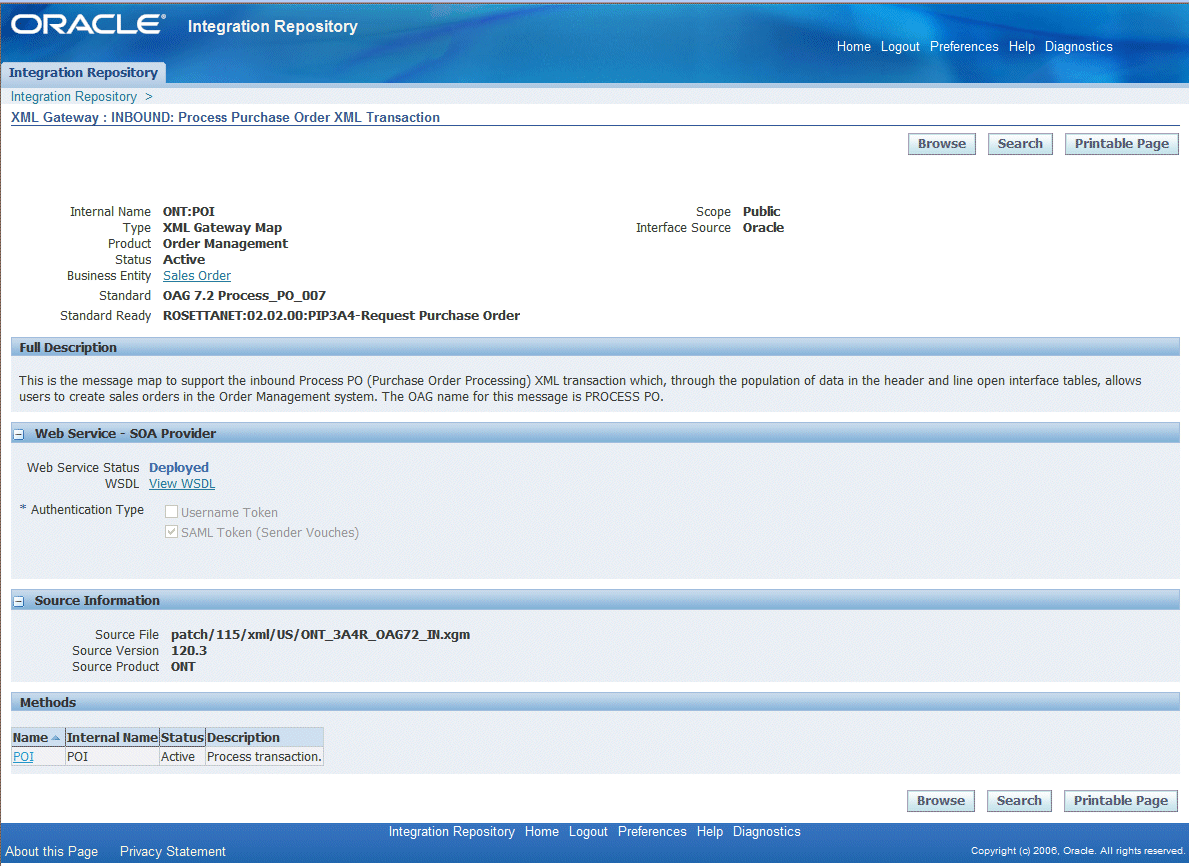
Each interface details page also includes Search and Printable Page allowing you to perform a search or view the details page of a selected interface in a printable format if you want. See Searching for an Integration Interface for details.
Important: Information specific to Web services is discussed under Understanding Service Enablement.
Information specific to composite services is discussed under Working with Composite Services.
Common Information on Interface Details
Each interface information page includes a header region with general information about the interface.
For information on SOAP and REST Web services, see Common Information on SOAP Web Services and Common Information on REST Web Services.
The following fields are common to almost all interface types:
| Field | Notes |
|---|---|
| Internal Name | This is the PL/SQL package name, the document name, or the Java service interface name.
Note: For Java service interfaces, this is called Qualified Name, and includes the full Java package name and the class name. |
| Type | Business interfaces are organized into interface types according to the integration technologies on which they're based. Examples of interface types supported in Integration Repository are PL/SQL, XML Gateway, Concurrent Programs, Business Events, Open Interface Tables, Open Interface Views, EDI, Business Service Object (Service Beans), Java, and Composite Service - BPEL. For more information about interface type, see interface type. |
| Product | The Oracle E-Business Suite product that supplies the interface. |
| Business Entity | Business entities are objects that either perform business activities or have business activities performed on them. For example, sales orders, account numbers, employees, purchase orders, customers, and receipts are all business entities. An interface can be used by multiple business entities, and a business entity can be accessed using multiple interfaces. The Business Entity field lists the business entities accessed by an interface. Click a business entity name to view a list of available interfaces to that entity. Note: This field does not appear for Java service interfaces. |
| Status | Valid status codes are:
|
| Scope | The scope can be one of the following:
For more information, see Scope on the Oracle Integration Repository Search page. |
| Interface Source | The only available interface source in Oracle Integration Repository is Oracle native packaged integration interfaces. Interface Source on the Oracle Integration Repository Search page. |
| MetaLink | Included for any interface that has a related My Oracle Support (formerly OracleMetaLink) Knowledge Document. Click the link to log in to My Oracle Support and view the Knowledge Document. A valid user name and password is required to access My Oracle Support. |
| Documentation | Included for any interface that has related online documentation. Click the link to view or download the documentation. |
| Online Help | Provided for any interface that has related Oracle E-Business Suite online help. Click the link to view online help for the interface. |
Each interface information page also includes a Source Information region that contains the following fields:
Integration repository administrators can find the following buttons available in the interface details page:
-
Generate WSDL: This generates a Web service WSDL file for a selected interface. If the file is generated successfully, you will find the Web Service region becomes available. Regenerate WSDL also appears in the details page allowing you to regenerate the service again if needed.
-
Deploy (Redeploy or Undeploy)
If the service has already been generated successfully, the administrators can find Deploy available in the Web Service region for the selected integration interface.
If a service has been deployed, the administrators can find Redeploy (or Undeploy) available instead. This allows the administrators to redeploy or undeploy the deployed Web service if needed.
Prior to deploying or redeploying the service to the application server, the administrators must first select at least one authentication type for the generated service. This allows SOA Provider services the deployment based on the selected type(s).
-
Create Grant: This allows the administrators to create security grants by authorizing the access permission of a selected interface method or a procedure or function to an appropriate user, a user group or all users.
Oracle Integration Repository also provides a feature to revoke the grants for a particular user for a selected method or service.
For more information on managing function security through security grants, see Managing Grants.
-
View Log
This allows the administrators to view the logs generated during service generation and deployment. If logging is enabled for specific services or all services at the Site level only, administrators can find View Log in the Interface Details page. Click View Log to open the Log Details page where you can view log details compiled in the log table. You can also delete and export log messages retrieved in the Log Details page if needed. For more information, see Viewing Generate and Deploy Time Logs, Oracle E-Business Suite Integrated SOA Gateway Implementation Guide.
To view the logs written in SOA Monitor during the invocation of Oracle E-Business Suite services by Web service clients, see Viewing Service Processing Logs, Oracle E-Business Suite Integrated SOA Gateway Implementation Guide.
Additional Information: The integration repository administrators (defined by the Integration Repository Administrator role) can find the Administration tab containing the following information displayed next to the Integration Repository tab:
-
SOA Monitor subtab: This allows the administrators to monitor and audit all SOAP messages in and out through SOA Provider and view the message details.
For information about how to use SOA Monitor, see Monitoring and Managing SOAP Messages Using SOA Monitor, Oracle E-Business Suite Integrated SOA Gateway Implementation Guide.
-
Log subtab: This allows the administrators to enable and configure log setups.
For information about log configuration, see Logging for Web Services, Oracle E-Business Suite Integrated SOA Gateway Implementation Guide.
Common Information on SOAP Web Services
For service-enabled interfaces, SOAP service information is displayed in the SOAP Web Service tab (or the Web Service region for XML Gateway interface only) of the interface details page.
Web Service Region(s) for XML Gateway Map
XML Gateway maps can be supported by both Web Service Provider in Release 12.0 and by SOA Provider in this release; therefore, for backward compatibility, a profile option FND: XML Gateway Map Service Provider is used to let you select an appropriate service provider in enabling services for XML Gateway Map interface type. Based on your selected profile value, the interface details page can display the 'Web Service - Web Service Provider region' or 'Web Service - SOA Provider region', or displayed both regions at the same time if a service is generated successfully.
See: XML Gateway Map Web Service Region.
The following fields are common in the SOAP Web Service tab or Web Service region to almost all interface types:
| Field | Description |
|---|---|
| Web Service Status (or SOAP Service Status if it's in the SOAP Web Service tab) |
This field indicates different state of a SOAP service during service generation and deployment life cycle.
|
| View WSDL | This link is shown after a selected interface has an associated SOAP service available. Click this link letting you review WSDL description for a generated or deployed service. See: Reviewing Web Service WSDL Source. |
| Service Operations table | This table displays the interface name along with the method names contained in the interface in a table. An integration administrator or an integration developer can generate the selected interface as a SOAP service. Note that this table is still updatable after service generation, but any changes to the table will be applied only after regenerating the service. |
| Authentication Type | To secure web service content and authenticate web service operation, before deploying a generated service, an integration repository administrator must select one desired authentication type for the selected service in the Authentication Type field.
Only users who have the Integration Repository Administrator role can select and modify the authentication type. For other users, this field is displayed in read-only mode. |
| Grant | The Grant icon is shown only in the SOAP Web Service tab (not the Web Service region). If the access permission of an operation has been granted to a specific user, user groups, or all users, then the Grant icon is available for the operation. Only users who have the Integration Repository Administrator role and the System Integration Developer role can find the Grant icon and view the grant details. |
Performing Administrative Activities for SOAP Web Services
Users who have the Integration Repository Administrator role can perform administrative tasks. These tasks include generating, deploying, undeploying, and redeploying SOAP services by clicking the following buttons in the interface details page:
-
Generate: This allows the administrators to generate a SOAP service. This transforms a selected integration interface definition into a web service using WSDL. After service generation, the administrators can regenerate or deploy the generated service if it's needed.
See Generating SOAP Web Services, Oracle E-Business Suite Integrated SOA Gateway Implementation Guide.
-
Deploy: If the SOAP service has already been successfully generated, the administrators can deploy the generated SOAP service to an Oracle E-Business Suite server.
If the web service is successfully deployed, the administrators can undeploy or redeploy the web service if needed. See Deploying and Undeploying SOAP Web Services, Oracle E-Business Suite Integrated SOA Gateway Implementation Guide.
-
Create Grant: The administrators can create security grants by authorizing access permissions of interface methods to a user, a user group, or all users.
The grant feature applies to both SOAP and REST service operations if the selected interface can be exposed as both SOAP and REST services. For more information on security grants, see Managing Grants.
-
View Log: This displays the Log Details page where the administrators can view and download the log details.
For more information on viewing logs recorded at design time, see Viewing Generate and Deploy Time Logs, Oracle E-Business Suite Integrated SOA Gateway Implementation Guide.
To view logs written in Service Monitor during the invocation of Oracle E-Business Suite SOAP services, see Viewing Service Processing Logs, Oracle E-Business Suite Integrated SOA Gateway Implementation Guide.
Additional Information: In addition to performing service management activities in the Integration Repository tab, integration repository administrators can perform other administrative tasks in the Administration tab that are outside the Integration Repository user interface. These tasks include:
-
Configuring Log Setups
This allows the administrators to enable and configure log setups for all services or specific services or operations. The administrators can easily monitor system activities, track and view log messages, and troubleshoot any issues encountered at each stage of service development life cycle.
For more information on SOA logging framework and how to enable and configure logs, see Logging for Web Services, Oracle E-Business Suite Integrated SOA Gateway Implementation Guide.
-
Monitoring SOAP Messages Using SOA Monitor
This allows the administrators to access SOA Monitor to monitor and audit all SOAP messages in and out from the SOA Provider (if the SOA auditing feature is enabled).
For more information on how to use SOA Monitor, see Monitoring and Managing SOAP Messages Using SOA Monitor, Oracle E-Business Suite Integrated SOA Gateway Implementation Guide.
Common Information on REST Web Services
If a selected interface can be exposed as a REST service, you can find the REST Web Service tab included in the interface details page. It can be an interface type of PL/SQL, Concurrent Program, Business Service Object, Open Interface Table or View, Java Bean Services, or Application Module Services.
The following fields are common in the REST Web Service tab:
| Field | Description |
|---|---|
| Service Alias | Each REST service should be associated with a unique alias name. Before deploying a REST service, the administrator must enter this field which will be used in service endpoint, WADL, XSDs, and namespaces. Please note the following guidelines when specifying the service alias:
|
| REST Service Status | This field indicates different state of a REST service during service life cycle.
In addition to 'Not Deployed' and 'Deployed' service states, more intermediate service statuses can be shown while the service is in the process of performing an action issued by the administrator and transforming to a different state. The following list describes intermediate service status information:
|
| View WADL | This link is displayed after the selected interface has an associated REST service deployed. Click this link letting you review WADL description for the deployed REST service. This field appears only when the REST service has been successfully deployed with 'Deployed' status. See: Reviewing Web Service WADL Source. |
| Verb | The Verb value indicates how the REST service is implemented using an HTTP method. For PL/SQL APIs and Concurrent Programs, if a selected interface is deployed (with 'Deployed' status) as a REST service, this field appears along with the "POST" HTTP method. Note: POST is the only supported HTTP method for PL/SQL APIs and Concurrent Programs. For Business Service Objects, Java Bean Services, Application Module Services, Open Interface Tables, and Open Interface Views, the supported verbs are displayed in the Service Operations Table instead. |
| REST Service Security | To secure REST service content, all REST services are secured by either one of the following security methods:
|
| Service Operations table | This table displays the list of procedures or functions contained in the selected interface that can be exposed as REST service operations. For more information on each field in the table, see Service Operations Table. |
The Service Operations table displays each method (or procedure or function) contained in the selected interface, and whether it is exposed as a service operation. Users who have the Integration Repository Administrator role can perform administrative tasks including deploying or undeploying services as well as creating or revoking security grants.
The following table describes each field in the Service Operations table:
| Field | Description |
|---|---|
| Display Name | This is the interface name used externally. |
| Internal Name | This is the interface name used internally. |
| Included Operations (PL/SQL APIs and Concurrent Programs Only) | This column appears when a selected PL/SQL API or Concurrent Program is exposed as a REST service. All the methods contained in the selected interface are automatically checked by default indicating that they are all exposed as REST service operations.
Note: All methods in a PL/SQL API are deployed with POST HTTP method. A Concurrent Program contains only single method; therefore, once it is deployed, the method within the interface is automatically deployed with POST as well. |
| GET (Business Service Object, Java Bean Services, Application Module Services, and Open Interface Tables and Views Only) |
This GET method column appears when a selected interface is an interface type of Business Service Object, Open Interface Table or View, Java Bean Services, or Application Module Services. For Business Service Object interfaces, the GET check box is enabled only if input parameters are of simple data types (String, Number, etc.). It is disabled if input parameters consist of complex data object types (AccountMergeRequest, etc.). For Java Bean Services and Application Module Services, this GET check box is preselected if a Java or an Application Module method is annotated with the GET HTTP method. The administrator can uncheck the preselected GET check box for the Java or Application Module method if it will not be published with the GET method. However, if it is not annotated with GET method, unlike the POST method, the GET check box becomes inactive or disabled for further selection. For Open Interface Tables with Inbound direction, four HTTP methods (GET, POST, PUT, and DELETE) are all displayed. For Open Interface Tables with Outbound direction and Open Interface Views, only the GET method is displayed in the table. |
| POST (Business Service Object, Java Bean Services, Application Module Services, and Open Interface Tables with Inbound direction Only) |
This POST method column appears when a selected interface is an interface type of Business Service Object, Java Bean Services, Application Module Services, or Open Interface Table with Inbound direction. For Business Service Object interfaces, select the POST check box if desired for a method to be deployed as a REST service operation. For Java Bean Services and Application Module Services, if a Java or an Application Module method is annotated with the POST method, similar to the GET method, this POST check box is preselected. The administrator can uncheck the preselected check box before deploying the service if the Java or Application Module method will not be published with the POST method. If it is not annotated with the POST method, unlike the GET method, the POST check box remains active or enabled by default. The administrator can still select the POST check box if needed for a method. For Open Interface Table with Inbound direction, select the POST check box if desired for an interface table to be deployed as a REST service operation. |
| PUT (Open Interface Tables with Inbound direction Only) | This HTTP method column appears only when the selected interface is an Open Interface Table with Inbound direction. |
| DELETE (Open Interface Tables with Inbound direction Only) | This HTTP method column appears only when the selected interface is an Open Interface Table with Inbound direction. |
| Grant | If the access permission of an operation has been granted to a specific user, user groups, or all users, then the Grant icon appears for the operation. Only users who have the Integration Repository Administrator role and the Integration Repository Developer role can find the Grant icon and view the grant details. |
Performing Administrative Activities for REST Web Services
REST services have a simplified service development life cycle. Users who have the Integration Repository Administrator role can perform the following administrative tasks in the interface details page:
-
Deploy (REST Web Service tab): This allows the administrators to deploy the REST service.
For more REST service deployment information, see Deploying REST Web Services, Oracle E-Business Suite Integrated SOA Gateway Implementation Guide.
-
Undeploy (REST Web Service tab): This action not only undeploys the service from the server to the Integration Repository, but also resets its status to the initial state 'Not Deployed'.
For more REST service undeployment information, see Undeploying REST Web Services, Oracle E-Business Suite Integrated SOA Gateway Implementation Guide.
-
Create Grant (Grants tab): The administrators select desired service operations before clicking Create Grant. The Create Grants page appears where grants can be created for a user, a user group, or all users.
The grant feature applies to both SOAP and REST services. For more information on security grants, see Managing Grants.
Reviewing Web Service WSDL Sources
To make integration interfaces available to customers over a network where customers can dynamically interact between applications, Oracle Integration Repository allows integration repository administrators (or users who have the Integration Repository Administrator role) to generate web services WSDL files.
Once a SOAP service represented in WSDL has been successfully generated, the SOAP service status is changed from 'Not Generated' to 'Generated'. The WSDL link appears in the SOAP Web Service tab (or the Web Service region for XML Gateway interface) allowing you to view the WSDL description.
Note: For XML Gateway Map interface type service enabled by Web Service Provider in Release 12.0, you will find a standard and deployed XML Gateway WSDL URL displayed with the 'Web Service Status - Deployed' status in the Web Service - Web Service Provider region.
For more information on service enablement support for XML Gateway Map interface type, see XML Gateway Map Web Service Region.
Interface Details Page with SOAP Web Service Tab
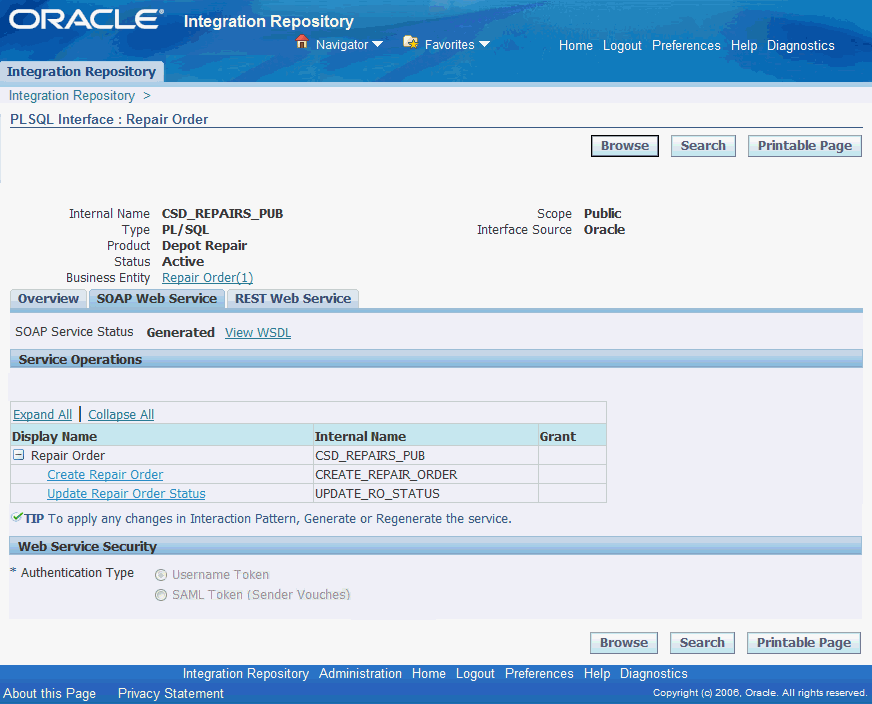
To view WSDL file:
-
Log in to Oracle E-Business Suite as a user who has the System Integration Analyst role. Select the Integrated SOA Gateway responsibility and the Integration Repository link from the navigation menu.
Locate your desired interface definition through a search or from the navigation tree.
-
Click the interface name to open the interface details.
-
Click the View WSDL link in the SOAP Web Service tab (or the Web Service region for XML Gateway interface) to view the WSDL source code.
The following sample shows the WSDL description for the PLSQL Interface: Repair Order:
<?xml version="1.0" encoding="UTF-8"?> <definitions name="CSD_REPAIRS_PUB" targetNamespace="http://xmlns.oracle.com/apps/csd/soaprovider/plsql/csd_repairs_pub/" xmlns="http://xmlns.oracle.com/apps/csd/soaprovider/plsql/csd_repairs_pub/" xmlns="http://schemas.xmlsoap.org/wsdl/" xmlns:soap="http://schemas.xmlsoap.org/wsdl/soap/" xmlns:tns1="http://xmlns.oracle.com/apps/csd/soaprovider/plsql/csd_repairs_pub/create_repair_order/" xmlns:tns2="http://xmlns.oracle.com/apps/csd/soaprovider/plsql/csd_repairs_pub/update_ro_status/">> <types> <schema xmlns="http://www.w3.org/2001/XMLSchema" elementFormDefault="qualified" targetNamespace="http://xmlns.oracle.com/apps/csd/soaprovider/plsql/csd_repairs_pub/create_repair_order/"> <include schemaLocation="http://<myhost>:<port>/webservices/SOAProvider/plsql/csd_repairs_pub/APPS_ISG_CREATE_REPAIR_ORDER_CSD_REPAIRS_PUB-24CREATE_REPAIR.xsd"/> </schema> <schema xmlns="http://www.w3.org/2001/XMLSchema" elementFormDefault="qualified" targetNamespace="http://xmlns.oracle.com/apps/csd/soaprovider/plsql/csd_repairs_pub/update_ro_status/"> <include schemaLocation="http://<myhost>:<port>/webservices/SOAProvider/plsql/csd_repairs_pub/APPS_ISG_UPDATE_RO_STATUS_CSD_REPAIRS_PUB-24UPDATE_RO_STA.xsd"/> </schema> <schema xmlns="http://www.w3.org/2001/XMLSchema" elementFormDefault="qualified" targetNamespace="http://xmlns.oracle.com/apps/csd/soaprovider/plsql/csd_repairs_pub/"> <element name="SOAHeader"> <complexType> <sequence> <element name="Responsibility" minOccurs="0" type="string" /> <element name="RespApplication" minOccurs="0" type="string" /> <element name="SecurityGroup" minOccurs="0" type="string" /> <element name="NLSLanguage" minOccurs="0" type="string" /> <element name="Org_Id" minOccurs="0" type="string" /> </sequence> </complexType> </element> </schema> </type> . . .Note: Values passed in the Responsibility, Responsibility Application, Security Group, NLS Language, and Organization ID complex types listed under the "SOAHeader" are used to set applications context during service execution.
Note that NLS Language and Organization ID are optional values to be passed. However, if the execution of a service is dependent on any particular organization, then you must pass the ORG_ID element in the "SOAHeader" of that SOAP request.
See: Setting Other Web Service Input Message Parts, Oracle E-Business Suite Integrated SOA Gateway Implementation Guide.
Note that the user information is defined by the
wsseUsernameproperty passed within the security headers. Detailed instructions on how to pass the security headers along with the SOAP request, see Passing Values to Security Headers, Oracle E-Business Suite Integrated SOA Gateway Developer's Guide.For more WSDL element information, see Reviewing WSDL Element Details, Oracle E-Business Suite Integrated SOA Gateway Developer's Guide.
To view a deployed WSDL file:
When an integration repository administrator successfully deploys or redeploys a web service, 'Deployed' appears in the SOAP Service Status field along with the deployed WSDL link in the SOAP Web Service tab or the appropriate Web Service region for an XML Gateway interface.
Click the View WSDL link to view the deployed WSDL file.
Reviewing Web Service WADL Sources
Once a REST Web service represented in WADL has been successfully deployed, the REST Service Status field is changed from 'Not Deployed' to 'Deployed'. The WADL link appears in the REST Web Service tab allowing you to view the WADL description.
For example, the following WADL description is for a PL/SQL API Invoice Creation (AR_INVOICE_API_PUB) that includes 'CREATE_INVOICE' and 'CREATE_SINGLE_INVOICE' REST service operations:
<?xml version="1.0" encoding="UTF-8" standalone="no" ?>
<application xmlns:tns="http://xmlns.oracle.com/apps/ar/soaprovider/plsql/rest/ar_invoice_api_pub/" xmlns="http://wadl.dev.java.net/2009/02"
xmlns:tns1="http://xmlns.oracle.com/apps/ar/rest/ar/create_invoice/" name="AR_INVOICE_API_PUB"
targetNamespace="http://xmlns.oracle.com/apps/ar/soaprovider/plsql/rest/ar_invoice_api_pub/">
<grammars>
<include xmlns="http://www.w3.org/2001/XMLSchema" href="https://host01.example.com
:1234/webservices/rest/Invoice/?XSD=CREATE_INVOICE_SYNCH_TYPEDEF.xsd" />
<include xmlns="http://www.w3.org/2001/XMLSchema" href="https://host01.example.com:1234/webservices/rest/Invoice/?XSD=CREATE_SINGLE_INVOICE_SYNCH_TYPEDEF.xsd" />
</grammars>
<resources base="http://host01.example.com:1234/webservices/rest/Invoice/">
...
</resources>
</application>
Note: The service alias value Invoice entered earlier before service deployment is now displayed as part of the schema for the service operations - 'CREATE_INVOICE' and 'CREATE_SINGLE_INVOICE'.
<?xml version="1.0" encoding="UTF-8" standalone="no" ?>
<application xmlns:tns=...
...
<resources base="http://host01.example.com:1234/webservices/rest/Invoice/">
<resource path="/create_invoice/">
<method id="CREATE_INVOICE" name="POST">
<request>
<representation mediaType="application/xml" type="tns1:InputParameters" />
<representation mediaType="application/json" type="tns1:InputParameters" />
</request>
<response>
<representation mediaType="application/xml" type="tns1:OutputParameters" />
<representation mediaType="application/json" type="tns1:OutputParameters" />
</response>
</method>
</resource>
<resource path="/create_single_invoice/">
<method id="CREATE_SINGLE_INVOICE" name="POST">
<request>
<representation mediaType="application/xml" type="tns2:InputParameters" />
<representation mediaType="application/json" type="tns2:InputParameters" />
</request>
<response>
<representation mediaType="application/xml" type="tns2:OutputParameters" />
<representation mediaType="application/json" type="tns2:OutputParameters" />
</response>
</method>
</resource>
</resources>
</application>
Note: POST is shown as the method name for two service operations 'CREATE_INVOICE' and 'CREATE_SINGLE_INVOICE'. This is the only HTTP method supported for PL/SQL REST services in this release.
Input and output messages can be exchanged in both the XML and JSON formats for both service operations.
If the deployed REST service is an interface type of Java Bean Services or Application Module Services, then both the GET and POST can be shown as the supported methods in the REST service operation. For example, the following WADL description shows many methods contained in the Employee Information service. The getPersonInfo operation is implemented with both the POST and GET HTTP methods.
<xml version="1.0" encoding="UTF-8">
<application name="EmployeeInfo" targetNamespace="http://xmlns.oracle.com/apps/per/soaprovider/pojo/employeeinfo/"
xmlns:tns="http://xmlns.oracle.com/apps/per/soaprovider/pojo/employeeinfo/"
xmlns="http://wadl.dev.java.net/2009/02" xmlns:xsd="http://www.w3.org/2001/XMLSchema"
xmlns:tns1="http://xmlns.oracle.com/apps/fnd/rest/empinfo/getallreports/"
xmlns:tns2="http://xmlns.oracle.com/apps/fnd/rest/empinfo/getdirectreports/"
xmlns:tns3="http://xmlns.oracle.com/apps/fnd/rest/empinfo/getpersoninfo/">
<grammars>
<include href="http://<hostname>:<port>/webservices/rest/empinfo/?XSD=getallreports.xsd" xmlns="http://www.w3.org/2001/XMLSchema" />
<include href="http://<hostname>:<port>/webservices/rest/empinfo/?XSD=getdirectreports.xsd" xmlns="http://www.w3.org/2001/XMLSchema" />
<include href="http://<hostname>:<port>/webservices/rest/empinfo/?XSD=getpersoninfo.xsd" xmlns="http://www.w3.org/2001/XMLSchema" />
</grammars>
<resources base="http://<hostname>:<port>/webservices/rest/empinfo/">
<resource path="/getAllReports/">
<method id="getAllReports" name="GET">
<request>
<param name="ctx_responsibility" type="xsd:string" style="query" required="false" />
<param name="ctx_respapplication" type="xsd:string" style="query" required="false" />
<param name="ctx_securitygroup" type="xsd:string" style="query" required="false" />
<param name="ctx_nlslanguage" type="xsd:string" style="query" required="false" />
<param name="ctx_orgid" type="xsd:int" style="query" required="false" />
</request>
<response>
<representation mediaType="application/xml" type="tns1:getAllReports_Output" />
<representation mediaType="application/json" type="tns1:getAllReports_Output" />
</response>
</method>
</resource>
<resource path="/getDirectReports/">
<method id="getDirectReports" name="GET">
<request>
<param name="ctx_responsibility" type="xsd:string" style="query" required="false" />
<param name="ctx_respapplication" type="xsd:string" style="query" required="false" />
<param name="ctx_securitygroup" type="xsd:string" style="query" required="false" />
<param name="ctx_nlslanguage" type="xsd:string" style="query" required="false" />
<param name="ctx_orgid" type="xsd:int" style="query" required="false" />
</request>
<response>
<representation mediaType="application/xml" type="tns2:getDirectReports_Output" />
<representation mediaType="application/json" type="tns2:getDirectReports_Output" />
</response>
</method>
</resource>
<resource path="="/getPersonInfo/ {personId}/">
<param name="personId" style="template" required="true" type="xsd:int" />
<method id="getPersonInfo" name="GET">
<request>
<param name="ctx_responsibility" type="xsd:string" style="query" required="false" />
<param name="ctx_respapplication" type="xsd:string" style="query" required="false" />
<param name="ctx_securitygroup" type="xsd:string" style="query" required="false" />
<param name="ctx_nlslanguage" type="xsd:string" style="query" required="false" />
<param name="ctx_orgid" type="xsd:int" style="query" required="false" />
</request>
<response>
<representation mediaType="application/xml" type="tns3:getPersonInfo_Output" />
<representation mediaType="application/json" type="tns3:getPersonInfo_Output" />
</response>
</method>
</resource>
<resource path="/getPersonInfo/">
<method id="getPersonInfo" name="POST">
<request>
<representation mediaType="application/xml" type="tns3:getPersonInfo_Input" />
<representation mediaType="application/xml" type="tns3:getPersonInfo_Output" />
</request>
<response>
<representation mediaType="application/xml" type="tns3:getPersonInfo_Input" />
<representation mediaType="application/xml" type="tns3:getPersonInfo_Output" /> </response>
</method>
</resource>
</resource path>
</application>
-
{personId}is a path variable, defined using the<param>tag after the<resource>tag and before the<method>tag. Client program should replace the path variable with actual value at run time. For example, an employee's Id will be passed in an HTTP GET request when thegetPersonInfoservice operation is invoked. This returns the associated employee's name and his or her manager's name.For information on how the path variable can be defined, see Annotations for Java Bean Services, Oracle E-Business Suite Integrated SOA Gateway Developer's Guide or Annotations for Application Module Services, Oracle E-Business Suite Integrated SOA Gateway Developer's Guide.
-
For the GET method, application context values, including
Responsibility, Responsibility Application, Security Group, NLS Language,andOrganization IDcomplex types, are passed as query strings in the RESTHeader element.
For more information about WADL description, see Reviewing WADL Element Details, Oracle E-Business Suite Integrated SOA Gateway Developer's Guide.
To view a deployed WADL file:
-
Log in to Oracle E-Business Suite as a user who has the System Integration Analyst role. Select the Integrated SOA Gateway responsibility and the Integration Repository link from the navigation menu.
The Integration Repository home page appears.
-
Locate your desired interface definition through a search or browse from the interface tree structure within the repository.
-
Click the interface name to open the interface details page.
-
In the REST Web Service tab, click the View WADL link to view the WADL source code.
Managing Grants
Only integration repository administrators (or users who have the Integration Repository Administrator role) can create security grants by authorizing the access permission of a selected interface method or procedure and function to an appropriate user, user group, or all users.
Managing Grants in the Grants Tab
Interface types that have the security grant feature available are PL/SQL, Concurrent Program, Business Service Object, Java Bean Services, Application Module Services, and Open Interface Table and View. You can manage grants for these interfaces using the Grants tab in the interface details page.
Note: Security grants for XML Gateway interfaces are managed in the Trading Partner User Setup Form although XML Gateway interfaces can only be exposed as SOAP services. See Managing XML Gateway User Security in the Trading Partner User Setup Form.
Interface Details Page with Grants Tab Highlighted
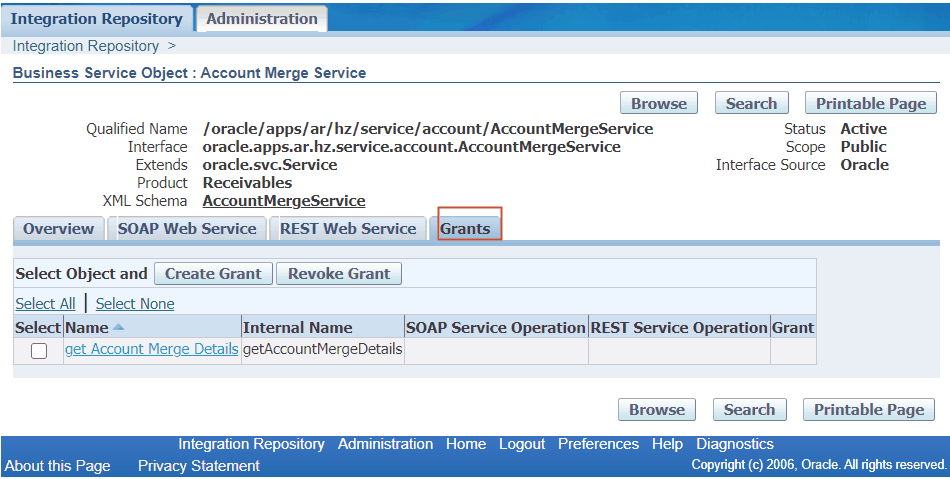
Note that the grant feature applies to the interfaces that can be exposed as both SOAP and REST services. These interfaces are PL/SQL, Concurrent Program, and Business Service Object.
For example, when a user (OPERATIONS) is authorized to have access permission on a PL/SQL API method name called 'Change User Name', the user will have the permission to access the associated 'Change User Name' service operations of both SOAP and REST service types through the same grant.
Creating Security Grants
To create a grant, select appropriate method name check boxes in the Grants tab. Click Create Grant to open the Create Grants page.
Create Grants Page

In the Create Grants page, select a grantee type and grantee name if it's applicable. Click Apply. This creates security grants for the selected methods.
Note that the grant action applies to both SOAP and REST PL/SQL services.
Revoking Security Grants
To revoke a grant in the Grants tab, the administrator can perform the action in two ways:
-
Revoking Grants for a Single Procedure and Function
Select a desired procedure and function from the Service Operations region first and then click Revoke Grant. The Revoke Grants page displays the existing grants details assigned to the selected procedure and function.
Revoke Grants Page with a Single Grant
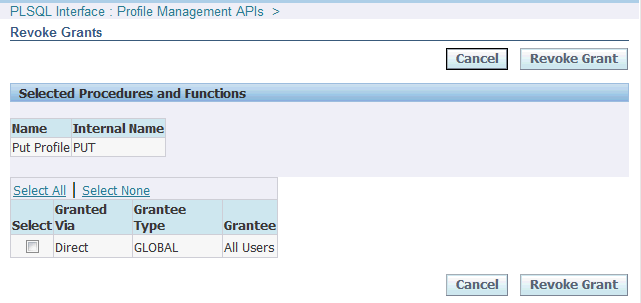
Select one or more existing grants from the table for the selected procedure, and click Revoke Grant to revoke the grants.
-
Revoking Commonly Assigned Grants to All Procedures
Select more than one procedure and function name that have grants created earlier, and click Revoke Grant in the Grants tab. The Revoke Grants page is displayed where the administrator can find existing grants that are commonly assigned to the selected procedures and functions.
For example, two procedures and functions (such as 'Get Profile' and 'Get Profile Value') are assigned to the same User (grantee type) 'operations' (grantee name). This common grant User 'operations' is displayed in the second table of the Revoke Grants page.
Revoke Grants Page with a Commonly Assigned Grant
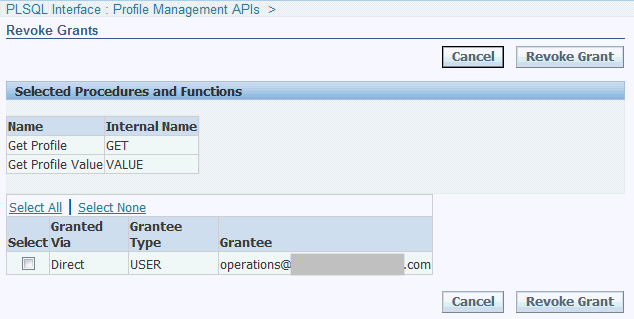
The administrator should be able to select the desired common grant(s) (such as User 'operations' in the above example) and click Revoke Grant. The specified common grant(s) should be removed for the selected procedures and functions.
For more information about how to manage grants in the Grants tab, see Managing Security Grants for the SOAP and REST Web Services, Oracle E-Business Suite Integrated SOA Gateway Implementation Guide.
Managing XML Gateway User Security in the Trading Partner User Setup Form
For XML Gateway interfaces, authorizing users to perform XML Gateway inbound transactions with a trading partner is performed in Oracle XML Gateway instead. The administrator needs to:
-
Set the "ECX: Enable User Check for Trading Partner" profile option to "Yes" to enable trading partner specific security feature
-
Associate users with a trading partner
Log in to Oracle E-Business Suite as a user who has the XML Gateway responsibility. Navigate to Setup and then select Define Trading Partners from the navigation menu. In the Define Trading Partner Setup form, click the User Setup button to access the Trading Partner User Setup form where the administrator can associate users with a trading partner.
For more information about trading partner user security, refer to Trading Partner Setup, XML Gateway Setup chapter, Oracle XML Gateway User's Guide.
XML Gateway Map Information
The following diagram illustrates the basic structure of the XML Gateway Map information page and its connections to related pages:
Basic Structure of the XML Gateway Information Page
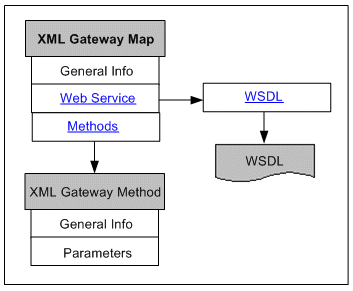
The XML Gateway Map information page contains the following information:
-
If the XML gateway map is exposed as a Web service, appropriate Web Service region(s) will be available.
-
Methods Region
The Methods region links to one or more XML Gateway Method information pages.
The general section of the XML Gateway Map displays common information.
The information page or interface details page includes a table listing the XML Gateway methods. Click a method name to access the information page for that method.
XML Gateway Map Web Service Region
To support the XML Gateway Map service enabled by Web Service Provider in Release 12.0 and to differentiate the service enablement by SOA Provider in this release, Oracle E-Business Suite Integrated SOA Gateway uses the following profile option to let you select an appropriate service provider in enabling services for XML Gateway Map interface type. Based on the selected profile value, the interface details page displays an appropriate Web Service region or more than one region.
Select one of the following values to define the FND: XML Gateway Map Service Provider profile option:
-
WSP (Web Service Provider)
This displays the Web Service - Web Service Provider region if Web services are available.
Web Service - Web Service Provider region
XML Gateway Map with Web Service - Web Service Provider Region

In Release 12.0, XML Gateway Map interface type were deployed by default through Web Service Provider; therefore, you can find a standard XML Gateway WSDL URL displayed in this region with the 'Web Service Status - Deployed' status.
http://<hostname>:<port>/webservices/AppsWSProvider/oracle/apps/fnd/XMLGateway?wsdl
-
SOAP (SOA Provider)
This is the default profile value which displays the Web Service - SOA Provider region if Web services are available.
Web Service - SOA Provider region
Note: The default profile value is set to 'SOAP'. However, if you do not start from this release and your system is upgrading from Release 12.0, you must change the profile value from the default 'SOAP' to 'Both' because Web Service Provider could have already been used in enabling services. To continue having service enabled using SOA Provider and for backward compatibility, both service providers should be enabled in transforming XML Gateway Map interface definitions into Web services. Otherwise, a fault message appears if it is still set to the default profile value 'SOAP' (SOA Provider).
If you start with Rapid Install of Oracle E-Business Suite for this release, the default service provider is SOA Provider ('SOAP' profile value). In this situation, Web Service Provider will be disabled and any invocations of generic XML Gateway Web services will return a fault message.
XML Gateway Map with Web Service - SOA Provider Region
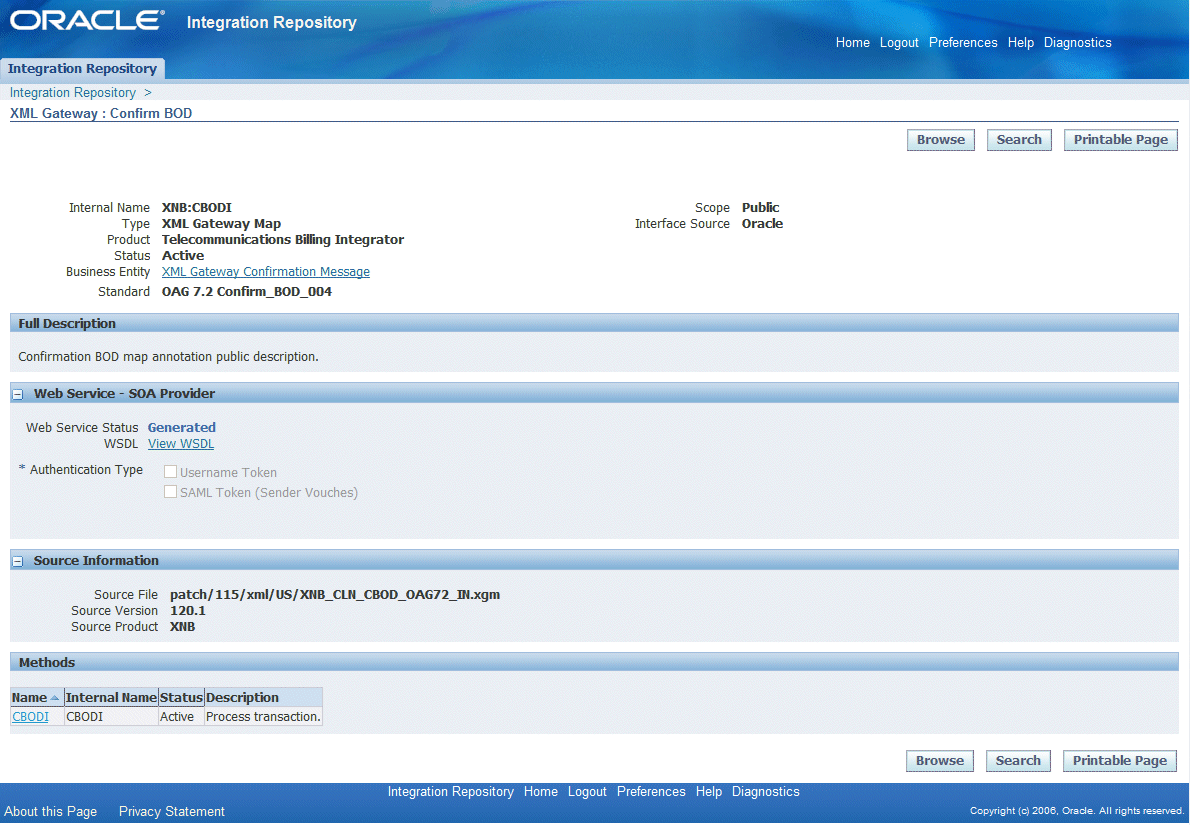
The View WSDL link is available along with appropriate Web Service Status information in the Web Service - SOA Provider region indicating whether the service is generated or deployed. For information on viewing WSDL description, see Reviewing Web Service WSDL Source.
To secure Web service content and authenticate Web service operation, SOA Provider supports multiple authentication types for inbound service requests. In addition to the Web Service Status field and View WSDL link, you can find the Authentication Type field with the following read-only check boxes:
-
Username Token: This authentication type provides username and password information in the security header for a Web service provider to use in authenticating the SOAP request.
-
SAML Token (Sender Vouches): This authentication type is used for Web services relying on sending a username only through SAML Assertion.
Before an integration repository administrator deploys a generated service, the administrator must select at least one authentication type for the selected service. See: Deploying and Undeploying Web Services, Oracle E-Business Suite Integrated SOA Gateway Implementation Guide.
-
-
Both
This displays both the Web Service - Web Service Provider region and Web Service - SOA Provider region in the interface details page if Web services are available.
For more profile option information used in Oracle E-Business Suite Integrated SOA Gateway, see Oracle E-Business Suite Integrated SOA Gateway Implementation Guide.
Integration repository administrators (defined by the Integration Repository Administrator role) can also find the following buttons available if the Web service has been generated successfully:
-
Deploy: Deploys the Web service.
-
Undeploy: Undeploys a Web service if the service has been deployed.
-
Redeploy: Redeploys the Web service if needed.
See: Performing Administrative Activities for SOAP Web Services.
XML Gateway Method Information
The XML Gateway method information page appears when you click a method name on an XML Gateway Map information page.
XML Gateway method information page
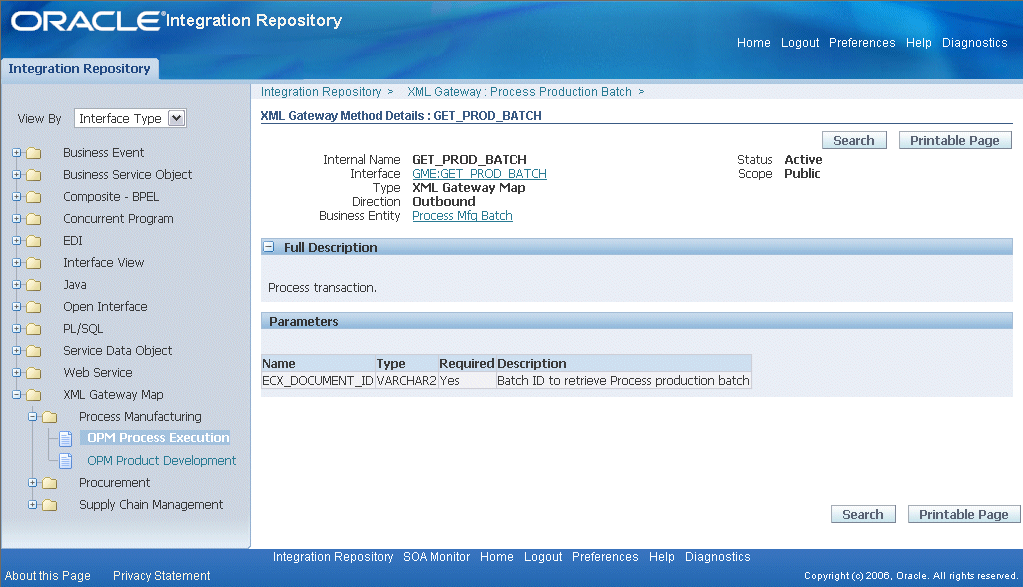
The general section of this page displays common information for the XML Gateway method, plus the following additional field:
Direction
-
Inboundindicates that the interface receives incoming transactions or messages into the Oracle E-Business Suite. -
Outboundindicates that the interface sends outgoing transactions or messages to another system.
This page also contains a table listing the XML Gateway method parameters, including each parameter's data type and whether the parameter is required.
PL/SQL Information
The following diagram illustrates the basic structure of the PL/SQL information page and its connection to the related PL/SQL procedure/function information page:
Basic Structure of the PL/SQL API Information Page
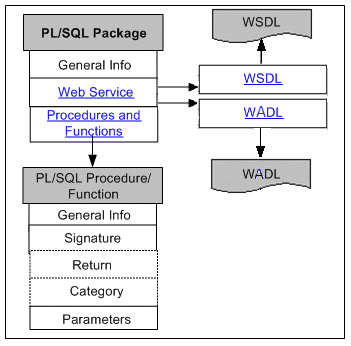
PL/SQL interfaces can be exposed as both SOAP services and REST services. Therefore, the PL/SQL interface details page includes general section of a selected PL/SQL interface, the Overview tab, the SOAP Web Service tab, and the REST Web Service tab.
Users who have the Integration Repository Administrator role can find an additional Grants tab displayed in the interface details page. This tab allows the administrators to create and revoke security grants. For more information on how to manage security grants, see Managing Grants.
For information on the general section, see Common Information.
PL/SQL Interface Details Page
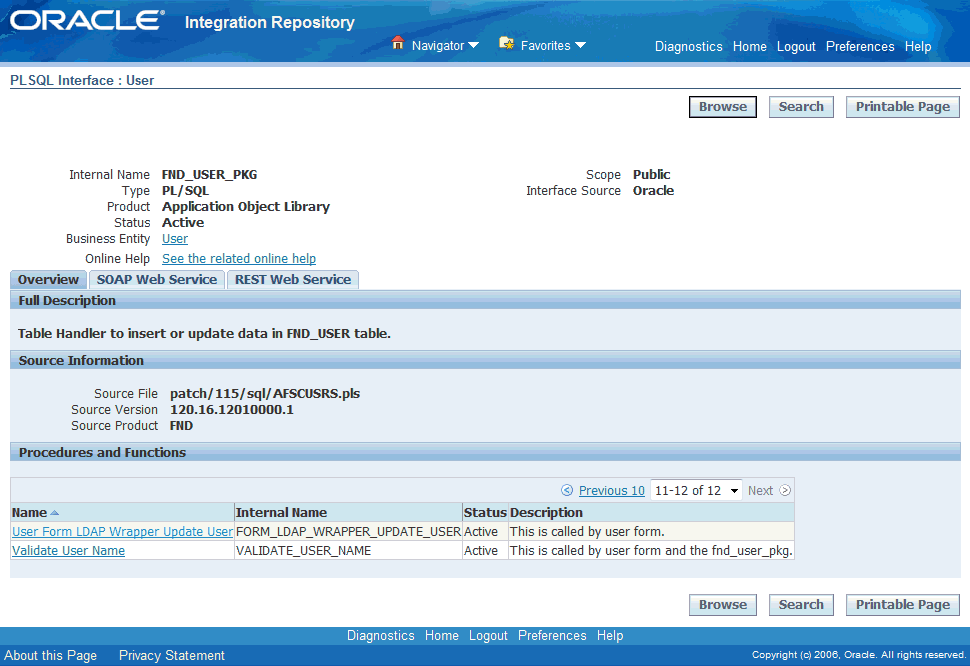
Note: For more information about Web services, see Understanding Web Services.
-
Overview Tab
This tab displays read-only information about the selected PL/SQL API. It includes full description, interface source information, as well as methods (or procedures and functions) contained in the selected interface.
For more information on the interface source information, see Common Information on Interface Details.
-
This tab contains SOAP service information for a selected PL/SQL interface. This includes service status, WSDL description, interaction pattern, and authentication type information.
For more information about SOAP service, see Common Information on SOAP Web Services.
For information on viewing WSDL description, see Reviewing Web Service WSDL Source.
If a SOAP service has been successfully generated, the administrators can perform additional administrative tasks including deploying the generated service, or regenerating the service.
For more information on these administrative tasks, see Performing Administrative Activities for SOAP Web Services.
-
REST Web Service Tab
This tab contains REST service information for the selected PL/SQL API. This includes service alias, service status, WADL description, verb, and service operation information.
Note that POST is the only HTTP verb supported in this release. For more information about REST service, see Common Information on REST Web Services.
All REST services are secured by HTTP Basic Authentication or Token Based Authentication at HTTP or HTTPS transport level. For more information on REST service security, see Managing Web Service Security, Oracle E-Business Suite Integrated SOA Gateway Implementation Guide.
Note: HTTPS is the recommended secure transport protocol while using the HTTP Basic Authentication security to authenticate user credentials (username and password).
If a REST service has been successfully deployed to an Oracle E-Business Suite application server, the administrators can undeploy the service to reset the service to its initial state - 'Not Deployed'.
For more information on these administrative tasks, see Performing Administrative Activities for REST Web Services.
PL/SQL Method Details Page
The PL/SQL method details page appears when you click a method name in the Overview tab, the SOAP Web Service tab, or the REST Web Service tab.
PL/SQL Method Details Page
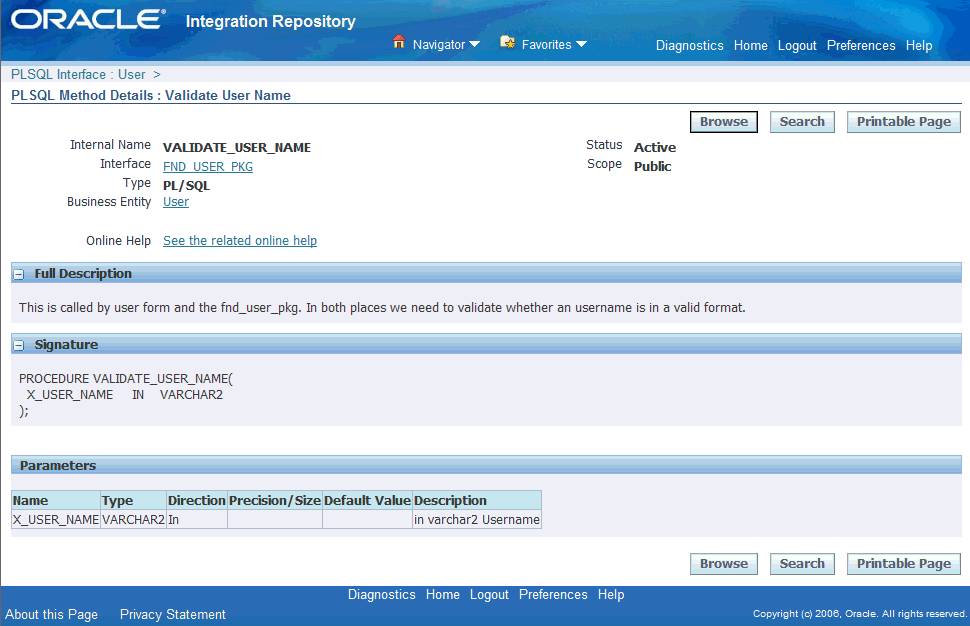
This page displays the signature of the selected method, and a table listing the parameters and their attributes.
Java Information
The following diagram illustrates the basic structure of the Java information page and its connection to the related Java method information page.
Basic Structure of the Java Information Page
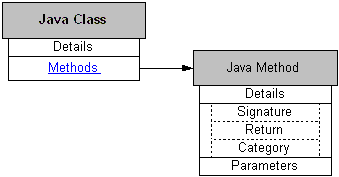
The general section of the Java information page displays common information for the selected Java class. This page also contains a table listing the class methods, including active status and internal name. Click the Java method name link to access the Java Method Details.
If you have the Integration Administrator role, the Grants tab appears. This lets you grant the access permissions of selected methods to a user, a user group, or all users. For more information on how to create security grants, see Managing Grants.
Java Method Details
The Java method details page appears when you click a method name on the Java interface details page.
Java method information page
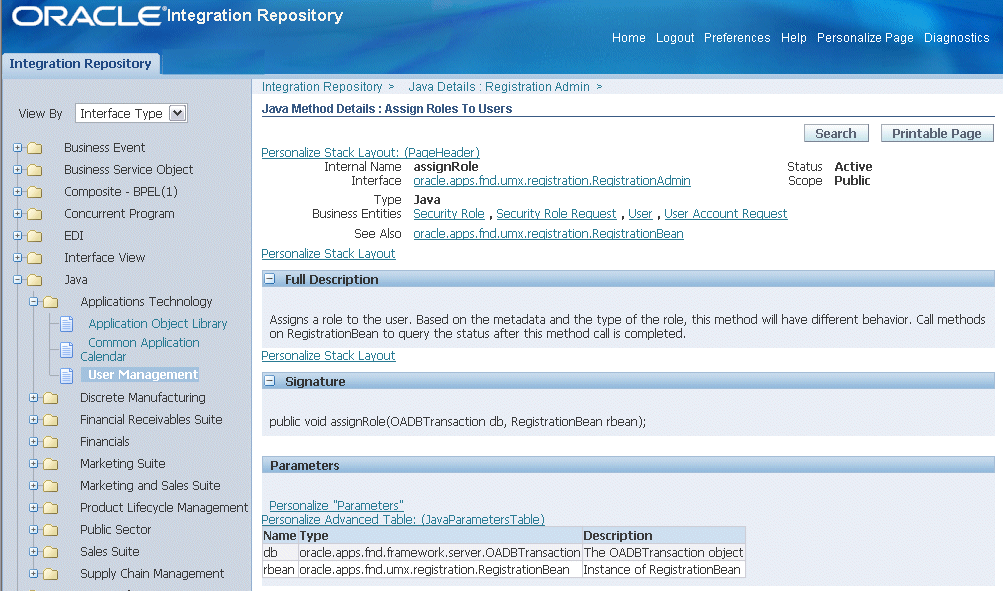
The general section of the Java method information page displays common information for the selected method, plus the following additional fields:
-
Interface
This Interface field displays the interface that uses this Java method. Click the link to view the interface details.
-
See Also
This See Also field displays a related Java method. Click a related Java method name link to view the Java method details.
This page also displays the signature of a selected method, information about the return type, and a table listing the method parameters.
Subtype of Java APIs
Some Java APIs are categorized as a subtype of Java interfaces. To locate those Java APIs, you must perform a search through the combination of Category and Category Value fields.
For information on how to locate these Java APIs through a search, see Searching for an Integration Interface.
If your selected interface belongs to these subtypes of Java APIs, the interface details page may contain Web service information if the selected interface is exposed as a service. For the interface details page of these APIs, see:
Java Bean Services
The following diagram illustrates the basic structure of the Java Bean Services information page and its connection to the related Java method details:
Basic Structure of the Java Bean Services Information Page

Searching Java Bean Services Interfaces
To easily locate Java Bean Services through the Search page, click Show More Search Options to display more search fields.
Enter the following key search values as the search criteria:
-
Category: Interface Subtype
-
Category Value: Java Bean Services
For information about category and category value fields, see Category and Category Value.
Viewing Java Bean Services
Java Bean Services can be exposed as REST services only. The interface details page contains the Overview tab and the REST Web Service tab. An integration repository administrator can find an additional Grants tab displayed in the page. This Grants tab allows the administrator to create and revoke security grants. For more information on how to manage security grants, see Managing Grants.
For information on the general section, see Common Information.
Note: For more information about web services, see Understanding Web Services.
Java Bean Service Interface Details Page with REST Web Service Tab
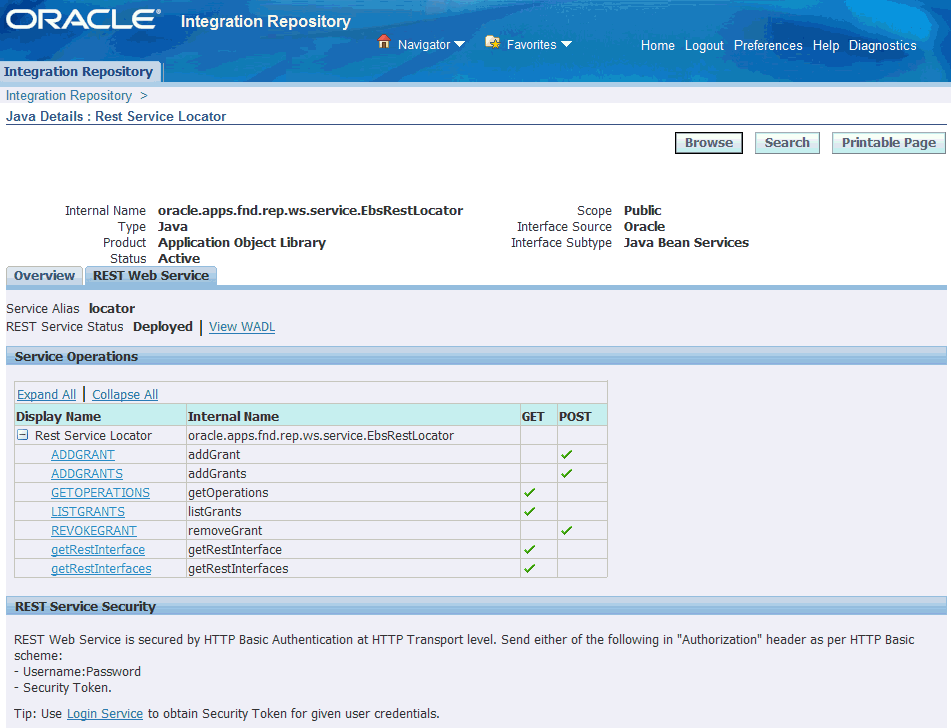
-
Overview Tab
This tab displays read-only information about the selected interface. It includes full description, interface source information, as well as methods contained in the interface.
For more information on the interface source information, see Common Information on Interface Details.
-
REST Web Service Tab
This tab contains REST service information for the selected interface. This includes service alias, service status, WADL description, verb, and service operation information.
For more information about REST service, see Common Information on REST Web Services.
For Java Bean Services annotation information, see Annotations for Java Bean Services, Oracle E-Business Suite Integrated SOA Gateway Developer's Guide.
Similar to the PL/SQL REST services, all Java Bean Services are secured by HTTP Basic Authentication or Token Based Authentication at HTTP or HTTPS transport level. For more information on REST service security, see Managing Web Service Security, Oracle E-Business Suite Integrated SOA Gateway Implementation Guide.
Note: HTTPS is the recommended secure transport protocol while using the HTTP Basic Authentication security to authenticate user credentials (username and password).
If a REST service has been successfully deployed, the administrator can undeploy the service to reset the service to its initial state - 'Not Deployed'.
For more information on these administrative tasks, see Performing Administrative Activities for REST Web Services.
Application Module Services
The following diagram illustrates the basic structure of the Application Module Services information page and its connection to the related Java method details:
Basic Structure of the Application Module Services Information Page
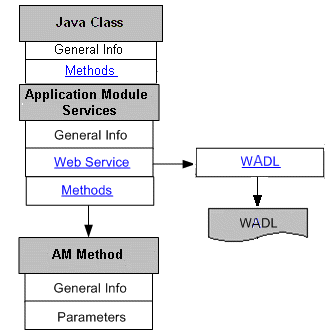
Searching Application Module Services Interfaces
To quickly locate Application Module Services through the Search page, click Show More Search Options to display more search fields. Enter the following key search values as the search criteria:
-
Category: Interface Subtype
-
Category Value: Application Module Services
For information about category and category value fields, see Category and Category Value.
Viewing Application Module Services
Similar to Java Bean Services that can be exposed as REST services only, the interface details page contains the Overview tab and the REST Web Service tab. An integration repository administrator can find an additional Grants tab for managing security grants. For more information on how to manage security grants, see Managing Grants.
For information on the general section, see Common Information.
Note: For more information about web services, see Understanding Web Services.
Application Module Service Interface Details Page

-
Overview Tab
This tab displays read-only information about the selected interface. It includes full description, interface source information, as well as methods contained in the interface.
For more information on the interface source information, see Common Information on Interface Details.
-
REST Web Service Tab
This tab contains REST service information for the selected interface. This includes service alias, service status, WADL description, verb, and service operation information.
For more information about REST service, see Common Information on REST Web Services.
For Application Module Services annotation information, see Annotations for Application Module Services, Oracle E-Business Suite Integrated SOA Gateway Developer's Guide.
Application Module Services are secured by HTTP Basic Authentication or Token Based Authentication at HTTP or HTTPS transport level. For more information on REST service security, see Managing Web Service Security, Oracle E-Business Suite Integrated SOA Gateway Implementation Guide.
Note: HTTPS is the recommended secure transport protocol while using the HTTP Basic Authentication security to authenticate user credentials (username and password).
If a REST service has been successfully deployed, the administrator can undeploy the service to reset the service to its initial state - 'Not Deployed'.
For more information on these administrative tasks, see Performing Administrative Activities for REST Web Services.
Security Services
Security services are a set of predefined and predeployed REST services from Oracle Application Object Library. These services include Authentication and Authorization services and are used for mobile applications.
For example, Login service validates the user credentials and returns an access token. Logout service invalidates the access token and any associated authentication sessions. These two services are included in the Authentication service that helps session initialization with security or applications context information. Authorization service retrieves the Access Control List which may contain assigned responsibilities, roles, and privileges for all logged-in users.
For more information about these REST security services, refer to the Oracle E-Business Suite Security Guide.
Searching and Viewing Security Services
To easily locate security services through the Search page, click Show More Search Options and then enter your search criteria in the Category (subtype) and the Category Value (Security Services) fields.
For information about category and category value fields, see Category and Category Value.
Viewing Security Service Interface Details
After a search, select a desired security service from the search results table. The interface details page for the selected security service is displayed. It contains some common interface information, REST Web Service region, and Methods region.
Security Service Interface Details Page
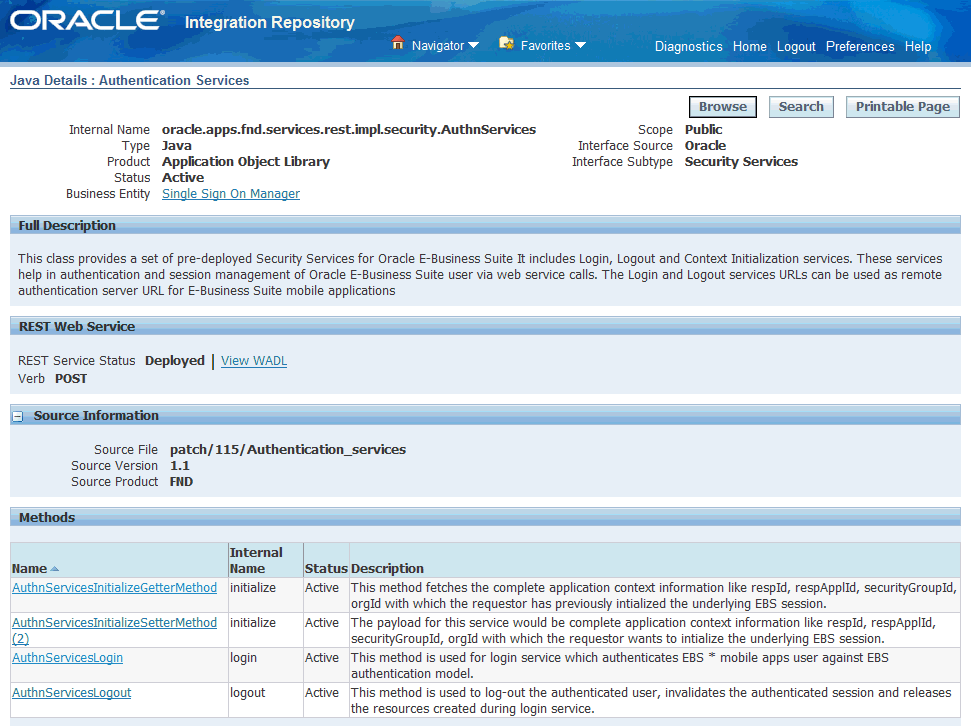
For information on the general section, see Common Information.
REST Web Service Region
The REST Web Service region contains the selected security service information.
-
REST Service Status: 'Deployed' is always displayed for security services because all security services are predeployed REST services.
Click the View WADL link to view the WADL description for the selected security service in a separate window.
-
Verb: This field displays the Verb value indicating how the REST service is implemented using an HTTP method.
'POST' is the only method supported in this release.
Please note that security services are pregranted to all Oracle E-Business Suite users which means that all the users can invoke these services.
Methods Region
In the Methods region, click a method name link to open the Java Method Details page for the selected method.
Java APIs for Forms
Java APIs for Forms are XML document-based integration points wrapped in Java classes for executing business logic in Oracle Forms.
Searching and Viewing Java APIs for Forms Interfaces
Similar to other subtype of Java APIs, you can perform a search by clicking Show More Search Options to quickly locate the Java APIs for Forms through the combination of Category (Interface Subtype) and Category Value (Java APIs for Forms) fields.
For information about category and category value fields, see Category and Category Value.
To view the interface details, select a desired Java APIs for Forms interface from the search result table. The selected interface details should appear.
Please note that Java APIs for Forms Web services are desupported in Oracle E-Business Suite Release 12.2. If you are planning to use this type of interfaces as Web services, you are advised to use alternate serviceable interfaces, such as PL/SQL and Business Service Objects interfaces, which can be deployed as Web services. Refer to My Oracle Support Knowledge Document 966982.1 for the suggested alternatives to the existing Java APIs for Forms services.
Business Service Object
Business service object interface type, formerly known as service bean, provides the access to SOA services and facilitates integration between Oracle E-Business Suite and trading partners. They can be used directly, or they can be exposed as SOAP or REST services. They often employ service data objects as parameters to pass complex data.
A service data objects (SDO) defines a generic API for accessing and manipulating structured data as part of a Service Oriented Architecture (SOA). It is designed to simplify and unify the way in which applications handle data. The SDO API is independent of the actual data source. For example, SDO can be used to access XML data or SQL data. For more information about SDO, see Reviewing Service Data Objects.
Note: A business service object is not actually an interface type; rather, it is an object used by one or more Java service interfaces or other service data objects to pass data. Oracle Integration Repository includes it on lists of interface types, so you can browse or search for Java service interfaces based on the business service objects that they use.
The following diagram illustrates the basic structure of the business service object interface information page and its connections to related pages:
Business Service Object Interface Basic Structure
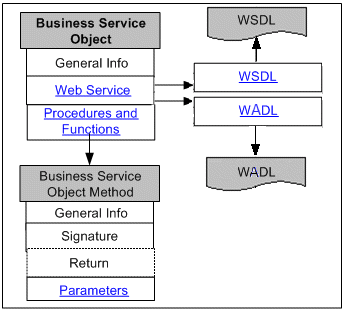
Business Service Object Interface Information
This interface type can be exposed as both SOAP services and REST services. The interface details page includes general section of a selected business service object interface, the Overview tab, the SOAP Web Service tab, and the REST Web Service tab.
Note: Users who have the Integration Repository Administrator role can find an additional Grants tab displayed in the interface details page. This tab allows the administrators to create and revoke security grants. For more information on how to manage security grants, see Managing Grants.
The general section displays common information for the selected business service object interface, plus interface name, the interface that extends, and XML schema information.
Note that an XML schema is a description of a type of XML document, typically expressed in terms of constraints on the structure and content of documents of that type. It describes all input and output message definition and data type. Click the XML schema link that is associated with your selected business service object to view the XML schema document displayed in a separate window.
For information on the general section, see Common Information.
For more information about web services, see Understanding Web Services.
Business Service Object Interface Details Page
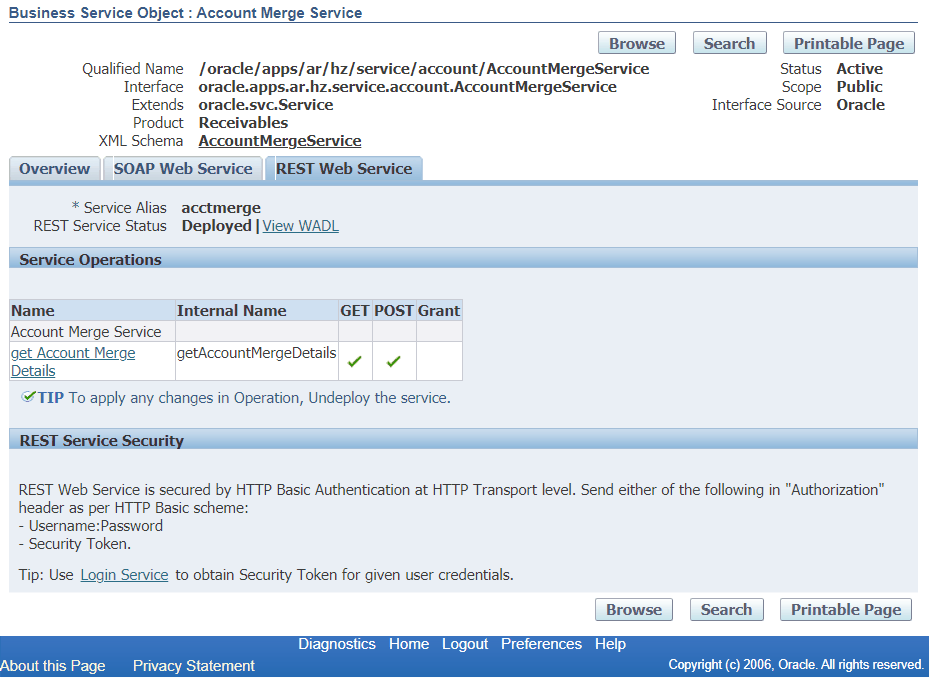
The business service object interface information page contains the following information:
-
Overview Tab
This tab displays read-only information about the selected business service object. It includes full description, interface source information, as well as methods contained in the selected business service object.
For more information on the interface source information, see Common Information on Interface Details.
For information about each method contained in the selected business service object interface, see Business Service Object Interface Method Information.
-
SOAP Web Service Tab
This tab contains SOAP service information for a selected business service object. This includes service status, WSDL description and authentication type information.
For more information about SOAP service, see Common Information on SOAP Web Services.
For information on viewing WSDL description, see Reviewing Web Service WSDL Source.
If a SOAP service has been successfully generated, the administrators can perform additional administrative tasks including deploying the generated service, or regenerating the service.
For more information on these administrative tasks, see Performing Administrative Activities for SOAP Web Services.
-
REST Web Service Tab
This tab contains REST service information for the selected business service object. This includes service alias, service status, WADL description, verb, and service operation information.
Note that POST and GET HTTP verbs are supported for BSO as REST service operations. For more information about REST service, see Common Information on REST Web Services.
All REST services are secured by HTTP Basic Authentication or Token Based Authentication at HTTP or HTTPS transport level. For more information on REST service security, see Managing Web Service Security, Oracle E-Business Suite Integrated SOA Gateway Implementation Guide.
Note: HTTPS is the recommended secure transport protocol while using the HTTP Basic Authentication security to authenticate user credentials (username and password).
If a REST service has been successfully deployed to an Oracle E-Business Suite application server, the administrators can undeploy the service to reset the service to its initial state - 'Not Deployed'.
For more information on these administrative tasks, see Performing Administrative Activities for REST Web Services.
Business Service Object Interface Method Information
The business service object interface method information page appears when you click a method name on the Overview tab, the SOAP Web Service tab, or the REST Web Service tab of the selected business service object interface details page.
Business Service Object Method Details Page
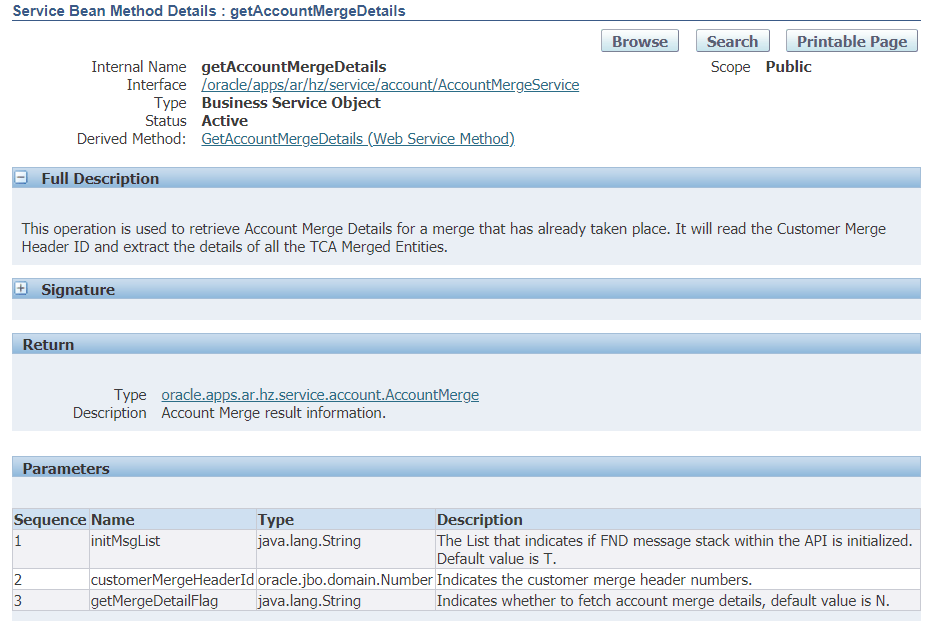
In addition to common information, the general section of the method details page contains a link to the interface that uses this method.
The following regions also appear on the method information page:
-
Signature
The region describes the interface method, parameter type, value, and return information.
-
Return
If the return type is a service data object, you can click the link in the Type field to access the service data object information page.
-
Parameters
If a parameter is a service data object, click the link in the Type column to access the service data object details page. See: Reviewing Service Data Object.
Integration Repository Service
Based on business service object interface, Integration Repository Service is a service component residing in Oracle Integration Repository. It queries Integration Repository data, and provides information about all the interface definitions to facilitate the integration between Oracle E-Business Suite and trading partners.
When you search for Integration Repository Service through the business service object interface type, all business service objects contained in the Integration Repository Service are displayed. You can grant the control access of each business service object method to appropriate users.
To access the Integration Repository Service interface, log in to Oracle E-Business Suite as a user who has the System Integration Analyst role and use the following steps to navigate to Integration Repository Service:
-
Select the Integrated SOA Gateway responsibility from the Navigator menu, and click the Integration Repository link that appears.
-
Click Search.
-
Enter the following information in the Search page:
-
Product Family: Application Technology
-
Interface Type: Business Service Object
-
-
Click Go to execute the search.
-
Click Integration Repository Service link from the search result table.
This opens the Business Service Object Interface information page. See: Business Service Object Interface information page.
-
Click a method name link in the Service Operations region to get to business service object method details.
Viewing WSDL Description
Click the View WSDL link in the SOAP Web Service tab to view the WSDL description generated.
The following sample shows the WSDL description for the Integration Repository Service:
<?xml version="1.0"?>
<definitions name="IntegrationRepositoryService"
targetNamespace="http://xmlns.oracle.com/oracle/apps/fnd/rep/ws/IntegrationRepositoryService"
xmlns="http://schemas.xmlsoap.org/wsdl/"
xmlns:xsd="http://www.w3.org/2001/XMLSchema"
xmlns:soap="http://schemas.xmlsoap.org/wsdl/soap/"
xmlns:tns2="http://xmlns.oracle.com/apps/fnd/ServiceBean"
xmlns:tns1="http://xmlns.oracle.com/apps/fnd/rep/ws"
xmlns:tns="http://xmlns.oracle.com/oracle/apps/fnd/rep/ws/IntegrationRepositoryService">
<types>
<xsd:schema>
<xsd:import namespace="http://xmlns.oracle.com/apps/fnd/rep/ws" schemaLocation="http://<hostname>:<port>/webservices/AppsWSProvider/oracle/apps/fnd/rep/ws/IntegrationRepositoryService.xsd"/>
</xsd:schema>
<xsd:schema elementFormDefault="qualified" targetNamespace="http://xmlns.oracle.com/apps/fnd/ServiceBean" >
<xsd:element name="ServiceBean_Header">
<xsd:complexType>
<xsd:element name="RESPONSIBILITY_NAME" minOccurs="0" type="xsd:string"/>
<xsd:element name="RESPONSIBILITY_APPL_NAME" minOccurs="0" type="xsd:string"/>
<xsd:element name="SECURITY_GROUP_NAME" minOccurs="0" type="xsd:string"/>
<xsd:element name="NLS_LANGUAGE" minOccurs="0" type="xsd:string"/>
<xsd:element name="ORG_ID" minOccurs="0" type="xsd:string"/>
</xsd:sequence>
</xsd:complexType>
</xsd:element>
</xsd:schema>
. . .
Note: Values passed in the Responsibility Name, Responsibility Application Name, Security Group, NLS Language, and Organization ID elements listed under the ServiceBean_Header are used to set applications context during service execution.
Please note that NLS Language and Organization ID are optional values to be passed. However, if the execution of a Business Service Object interface is dependent on any particular organization, then you must pass the ORG_ID element in the ServiceBean_Header of that SOAP request.
For more information, see Setting Other Web Service Input Message Parts, Oracle E-Business Suite Integrated SOA Gateway Implementation Guide.
Please note that the user information is defined by the wsseUsername property passed within the security headers. Detailed instructions on how to pass the security headers along with the SOAP request, see Passing Values to Security Headers, Oracle E-Business Suite Integrated SOA Gateway Developer's Guide.
You might find the following information under <Method>_Response about error messages if occur:
...
<xsd: complexType name ="IntegrationRepositoryService_GetServiceDescription_Response">
...
<xsd:sequence>
<xsd:element name="serviceDescription" type="oans3:ServiceDescription" minOccurs="0" nillable="true"/>
<xsd:element name="Message" type="oans1:ServiceMessage" minOccurs="0" maxOccurs="unbounded"/>
<xsd:element name="ErrorMessage" type="oans1:ServiceMessage" minOccurs="0" maxOccurs="unbounded"/>
</xsd:sequence>
</xsd: complexType name>
Note: The Message and ErrorMessage elements listed under <Method>_Response are used for error messages if occur. The Message element will appear as warning messages in the SOAP response. It is used to display any warning messages returned by the API. The ErrorMessage element corresponds to OAExceptions that were raised during the method invocation. In general, the response for any service method can contain any of the following:
-
The original output data
-
Warning messages if any (in <Message> element)
-
OAExceptions raised during the method invocation if any (in <ErrorMessage> element)
For more information about error messages, see Error Handling section, Building an OA Framework Application (the Basics) chapter, Oracle Application Framework Developer's Guide, available from My Oracle Support Knowledge Document 1087332.1, Oracle Application Framework Release Notes for Release 12.1.3.
Reviewing Service Data Object
A service data objects (SDO) defines a generic API for accessing and manipulating structured data as part of a Service Oriented Architecture (SOA). It is designed to simplify and unify the way in which applications handle data. The SDO API is independent of the actual data source. For example, SDO can be used to access XML data or SQL data.
The data objects associated with business service objects include service data objects (SDO) and filter data objects (FDO).
Service Data Object Information
This page is accessible from the getDataList and processDataList method information pages. You can also access it directly from the Oracle Integration Repository browse interface, through the list of interface types.
The following diagram illustrates the basic structure of the service data object information page and its connections to related pages.
Service Data Object Basic Structure

The general section of the service data object page displays common information, plus the data object class name, implementation name, and its associated XML schema.
Click the XML schema name link to view the schema document displayed in a separate window.
Note: An XML schema describes the structure of an XML document with all input and output message definitions and data types.
Service Data Object Details Page

The following regions also appear on the service object information page:
-
Fields
Click a link in the Name column to view the field's complete attributes.
If the field type is a filter, you can click the link in the Type column to access the filter data object information page for that filter.
-
Alternate Key Sets
These are the key sets that can be used to identify an instance of this data object in the absence of the primary keys. These key sets are evaluated in the sequence specified.
-
Filters
The Filters region lists filters that can be used to filter data sources based on this service data object.
For example, data sources based on BaseDataSourceNameDomain service data object can be filtered by BaseDataSourceNameFilter filter data object.
Click the name of a filter (such as BaseDataSourceNameFilter) to access the selected filter data object information page.
-
Services
The Services region lists the services that directly use this service data object.
Click the name of a service to access the information page for a business service object interface that uses this service object.
-
Service Data Objects
This Service Data Objects region lists the data objects that directly reference this service data object.
Click the name of a service data object to access its information page.
-
Methods
Click a link in the Name column to access the service object method information page.
Filter Data Object Information
This page is accessible only from the getDataList method information page.
The following diagram illustrates the basic structure of the filter data object information page and its connections to related pages.
Filter Data Object Basic Structure
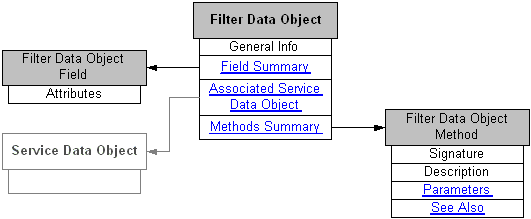
A filter data object is a type of service object. The general section of the filter data object page displays common information, plus the data object class name, implementation name, filter type, and its associated XML schema information.
Note: There are two types of filter:
-
Expression Filter: Allows a client program to construct a simple or complex expression, including nested expressions.
-
Fixed Filter: Allows a simple list of attributes. This is used when the view object must do custom processing of filter attributes and the client program should not be allowed to build nested and complex filter expressions.
For more information on filters, see the Oracle Application Framework Developer's Guide, available from My Oracle Support Knowledge Document 1087332.1, Oracle Application Framework Release Notes for Release 12.1.3.
Click the XML schema name link to view the schema document displayed in a separate window.
Filter Data Object Information Page
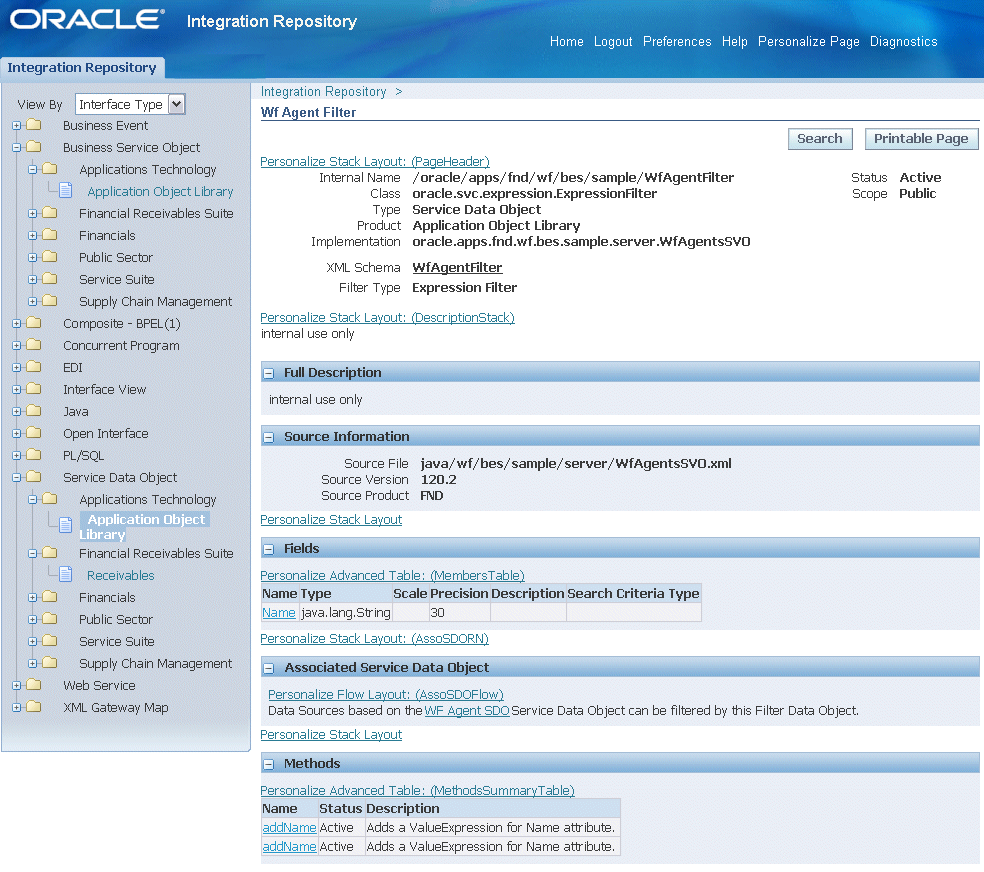
The following regions also appear on the service object information page:
-
Fields
Click a link in the Name column to view the field's complete attributes.
-
Associated Service Data Object
This region describes the associated service data object name that can be filtered by this selected filter data object.
Click the name of a service data object to access the service data object information page.
-
Methods
Click a link in the Name column to access the object method information page.
Service Data Object Method Information
The type of information provided for filter data object methods is the same as for service data object methods. The data object method information page appears when you click a method name on the service data object information page or the filter data object information page.
Service Data Object Method Information Page
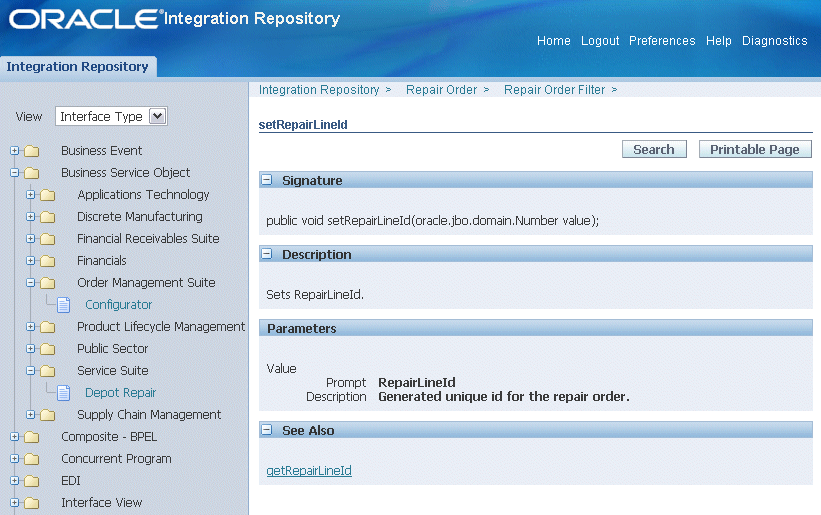
In addition to a description, the following regions also appear on the service data object method information page:
-
Signature
This region describes the interface method, parameter type, value, and return type information.
-
Parameters
This region contains descriptions of the parameters that are listed in the Signature region.
-
See Also
This region displays related service object methods. Click a related object method link to access the selected service object method details.
Concurrent Program Information
The following diagram illustrates the basic structure of the concurrent program information page and its connection to the related Open Interface information page:
Basic Structure of the Concurrent Program Information Page
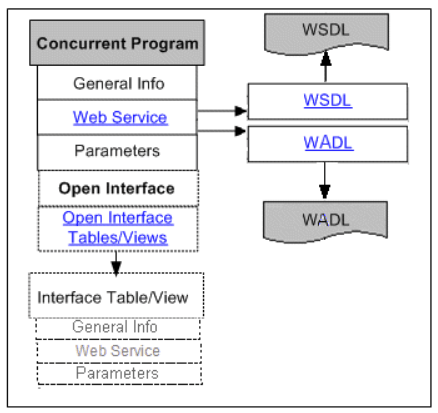
Concurrent programs can be exposed as both SOAP services and REST services. Therefore, the interface details page includes general section of a selected concurrent program, the Overview tab, the SOAP Web Service tab, and the REST Web Service tab.
Users who have the Integration Repository Administrator role can find an additional Grants tab displayed in the interface details page. This tab allows the administrators to create and revoke security grants. For more information on how to manage security grants, see Managing Grants.
For information on the general section, see Common Information.
Concurrent Program Interface Details Page

Note: For more information about Web services, see Understanding Web Services.
The concurrent program details page contains the following information:
-
Overview Tab
This tab displays read-only information about the selected concurrent program. It includes full description, interface source information, as well as concurrent program specific parameters contained in the selected concurrent program.
For more information on the interface source information, see Common Information on Interface Details.
-
This tab contains SOAP service information for a selected concurrent program. This includes service status, WSDL description, interaction pattern, and authentication type information.
For more information about SOAP service, see Common Information on SOAP Web Services.
For information on viewing WSDL description, see Reviewing Web Service WSDL Source.
If a SOAP service has been successfully generated, the administrators can perform additional administrative tasks including deploying the generated service, or regenerating the service.
For more information on these administrative tasks, see Performing Administrative Activities for SOAP Web Services.
-
REST Web Service Tab
This tab contains REST service information for the selected concurrent program. This includes service alias, service status, WADL description, verb, and service operation information.
Please note that POST is the only HTTP verb supported in this release. For more information about REST service, see Common Information on REST Web Services.
All REST services are secured by HTTP Basic Authentication or Token Based Authentication at HTTP or HTTPS transport level. For more information on REST service security, see Managing Web Service Security, Oracle E-Business Suite Integrated SOA Gateway Implementation Guide.
Note: HTTPS is the recommended secure transport protocol while using the HTTP Basic Authentication security to authenticate user credentials (username and password).
If a REST service has been successfully deployed to an Oracle E-Business Suite application server, the administrators can undeploy the service to reset the service to its initial state - 'Not Deployed'.
For more information on these administrative tasks, see Performing Administrative Activities for REST Web Services.
Concurrent Program Method Details Page
The concurrent program method details page appears when you click a method name in the Overview tab, the SOAP Web Service tab, or the REST Web Service tab.
Note: Oracle Integration Repository supports REST service enablement for Open Interface Tables and Views. If a concurrent program is linked to an open interface table or view, this concurrent program can be viewed and displayed under the Open Interface category and can be available as a REST service.
For more information about the Open Interface integration type, see Open Interface Information.
In the Parameters region, the parameters used in the selected interface are listed in a table. It includes parameter name, parameter type, required or not, displayed or not, and description information.
Open Interface Information
Open Interface integrations are always implemented using concurrent programs; therefore, the Interface Type in the header region of the Open Interface details page is categorized as "Concurrent Program & Open Interface".
This type of interface stores the interface data, including active status, and whether it stores data inbound to Oracle E-Business Suite or outbound to another system.
The following diagram illustrates the basic structure of the Open Interface information and its connection to the related interface table or view information page.
Basic Structure of the Open Interface Information Page
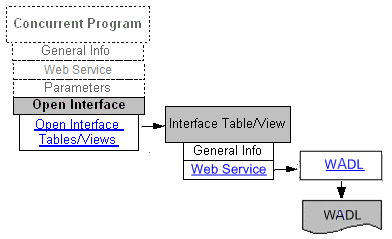
The Open Interface information table lists the open interface tables and views that store the interface data, including active status, and whether it stores data inbound to Oracle E-Business Suite or outbound to another system. Click an interface table name to access the information page for that table.
Open Interface List
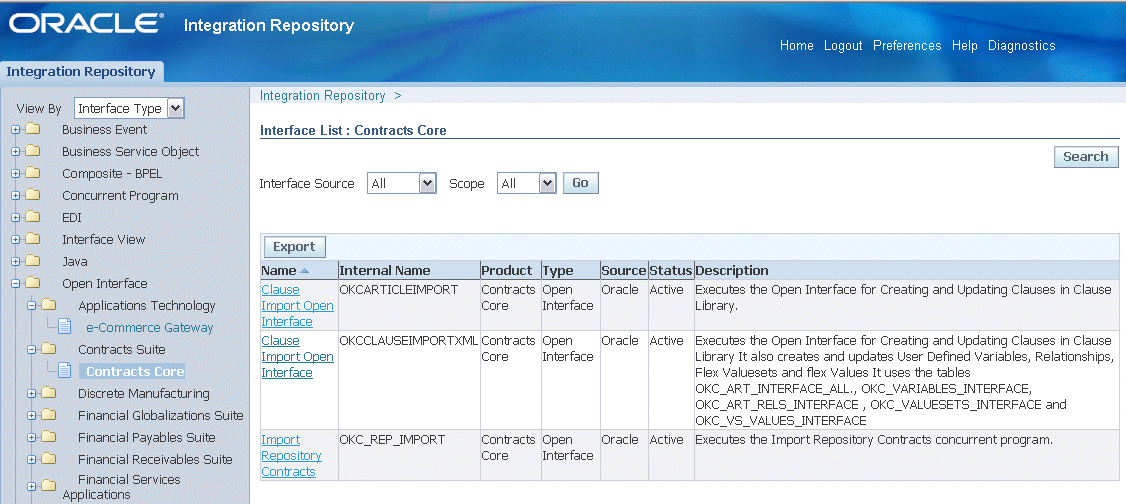
Open Interface integrations can be available as REST services. The interface details page includes general section of a selected open interface, the Overview tab and the REST Web Service tab.
Users who have the Integration Repository Administrator role can find an additional Grants tab displayed in the interface details page. This tab allows the administrators to create and revoke security grants. For more information on how to manage security grants, see Managing Grants.
For information on the general section, see Common information.
Open Interface Information
The Open Interface details page appears when you click an Open Interface name from the interface list table in the Integration Repository.
Open Interface Details Page

The Open Interface details page contains the following information:
-
Overview Tab
This tab displays read-only information about the selected open interface table. It includes full description, interface source information, as well as concurrent program specific parameters.
For more information on the interface source information, see Common Information on Interface Details.
-
REST Web Service Tab
If the selected Open Interface is an open interface table, click the REST Web Service tab to display the REST service information. This includes service alias, service status, WADL description, verb, and service operation information.
Please note that the supported HTTP verbs are determined by the direction of an open interface table.
-
For an open interface table with
Inbounddirection, all four HTTP methods – GET, POST, PUT, and DELETE – can be shown as REST service operations if they were all selected during the service deployment. -
For an open interface table with
Outbounddirection, only the GET HTTP method can be shown. -
For the associated concurrent program (
SUBMIT_CP_<internal name of the associated concurrent program>, such asSUBMIT_CP_RAXMTR) shown as the last entry in the table, only the POST HTTP method can be shown.
For more information about REST service, see Common Information on REST Web Services.
All REST services are secured by HTTP Basic Authentication or Token Based Authentication at HTTP or HTTPS transport level. For more information on REST service security, see Managing Web Service Security, Oracle E-Business Suite Integrated SOA Gateway Implementation Guide.
Note: HTTPS is the recommended secure transport protocol while using the HTTP Basic Authentication security to authenticate user credentials (username and password).
If a REST service has been successfully deployed, the administrator can undeploy the service to reset the service to its initial state - 'Not Deployed'.
For more information on these administrative tasks, see Performing Administrative Activities for REST Web Services.
-
Open Interface Table Details Page
Click a name link in the Service Operations table to display the selected Open Interface Table details page containing interface table columns and their attributes, such as data type, data length, data precision, data scale, and data requirement.
Open Interface Table Details Page

Interface View Information
The general section of the interface view information page displays when you browse from the tree nodes.
Open Interface View List

When you click the Open Interface view name from the interface list table in the Integration Repository, the Open Interface View details page appears.
Open Interface View Details Page
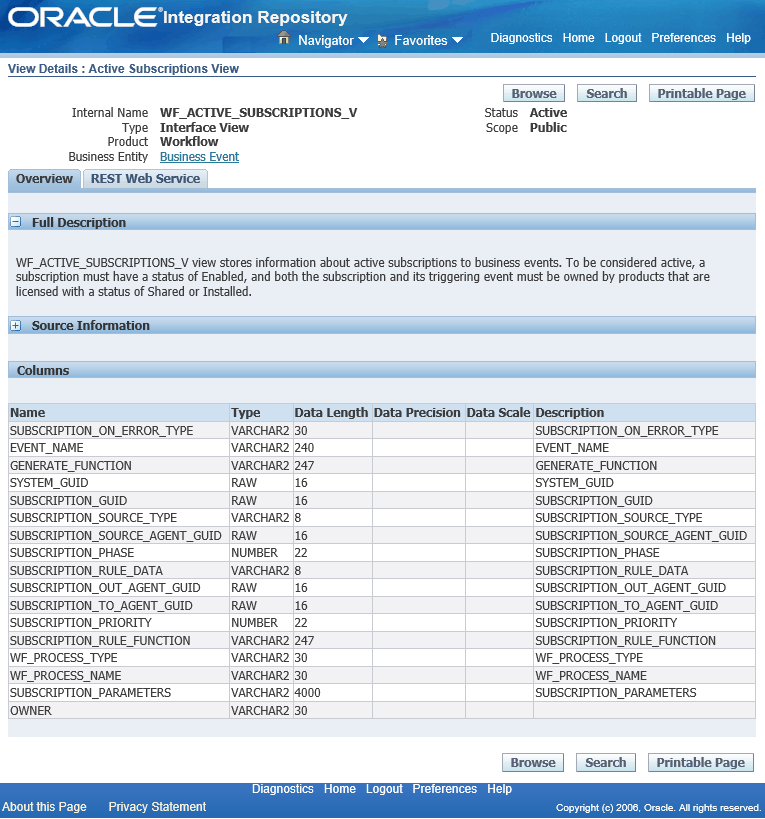
Similar to the interface details page for open interface table, the open interface view details page contains the following information:
-
Overview Tab
This tab displays read-only information about the selected open interface view. It includes full description, interface source information, and column information.
For more information on the interface source information, see Common Information on Interface Details.
-
REST Web Service Tab
This REST Web Service tab contains REST service information for the selected interface view. This includes service alias, service status, WADL description, verb, and service operation information.
Unlike open interface table that can be exposed as a REST service operation with various HTTP methods, GET is the only supported method for open interface view.
For more information about REST service, see Common Information on REST Web Services.
All REST services are secured by HTTP Basic Authentication or Token Based Authentication at HTTP or HTTPS transport level. For more information on REST service security, see Managing Web Service Security, Oracle E-Business Suite Integrated SOA Gateway Implementation Guide.
Note: HTTPS is the recommended secure transport protocol while using the HTTP Basic Authentication security to authenticate user credentials (username and password).
If a REST service has been successfully deployed, the administrator can undeploy the service to reset the service to its initial state - 'Not Deployed'.
For more information on these administrative tasks, see Performing Administrative Activities for REST Web Services.
EDI Message Information
The general section of the EDI message information page displays common information for the selected EDI message.
EDI message information page
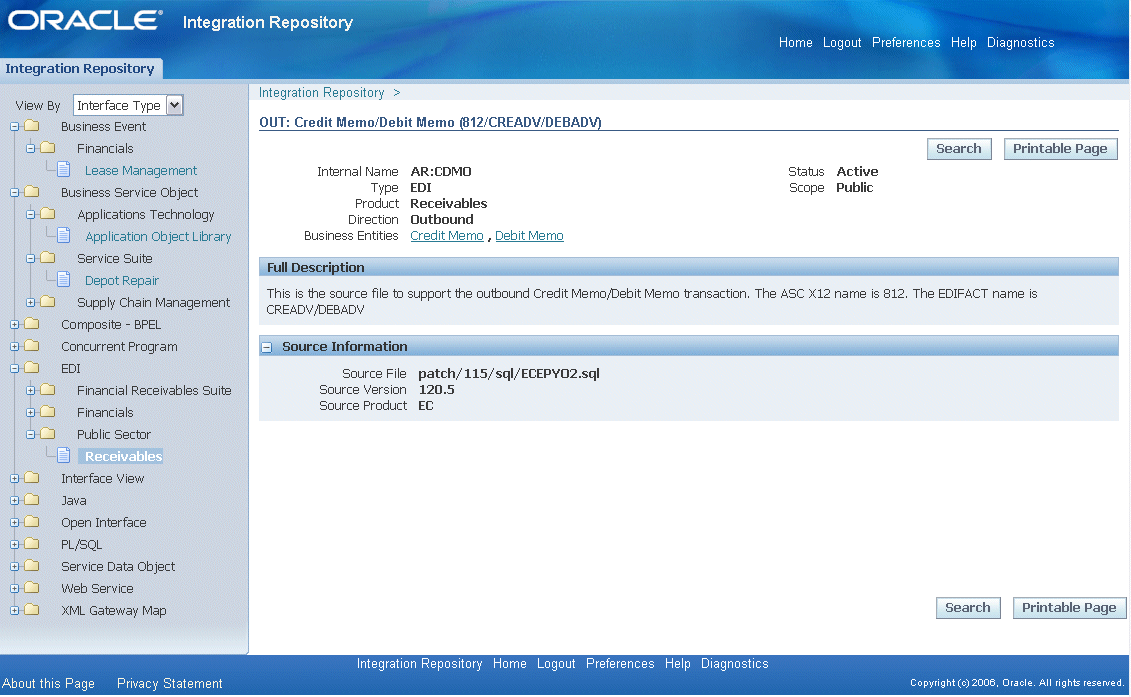
The EDI Message information page also displays the message direction in the Direction field:
-
Inboundindicates that the interface is for receiving an incoming transaction or message into Oracle E-Business Suite. -
Outboundindicates that the interface is for sending an outgoing transaction or message to another system.
Business Event Information
The general section of the Business Event displays common information for business event.
Business Event Details Page
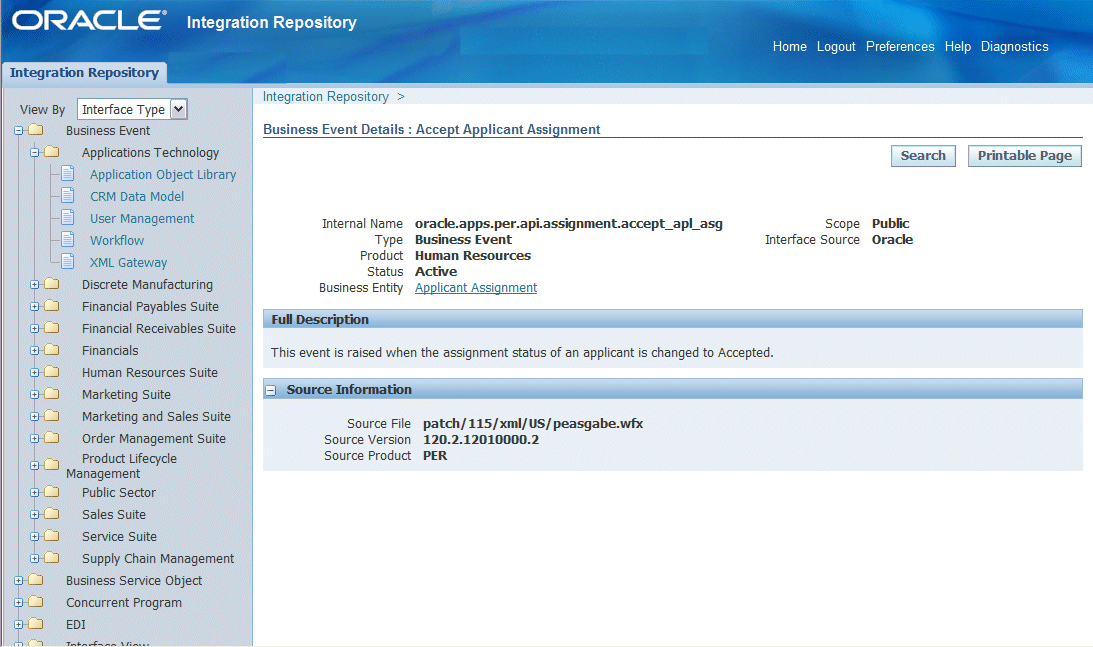
An integration repository administrator can perform the administrative tasks:
-
Subscribe to an event
An administrator can find the Subscribe button available in the event details page if the selected event is not subscribed. Clicking the Subscribe button lets you subscribe to the selected business event. Internally, an event subscription is automatically created for that event with
WF_BPEL_QAGENTas Out Agent. Once the event subscription has been successfully created, a confirmation message appears on the Business Event interface detail page.To consume the business event message, you should register to dequeue the event from Advanced Queue
WF_BPEL_Q. If a business event is enabled and if there is at least one subscriber registered to listen toWF_BPEL_Q, then the event message will be enqueued inWF_EVENT_Tstructure to Advanced QueueWF_BPEL_Q.For more information on how to dequeue messages, see the Oracle Streams Advanced Queuing User's Guide and Reference.
-
Unsubscribe the event
The Unsubscribe button becomes available in the details page if the selected event has been subscribed. Clicking the Unsubscribe button lets you remove or unsubscribe the event.
For more information about subscribing to business events, see Subscribing to Business Events, Oracle E-Business Suite Integrated SOA Gateway Implementation Guide.